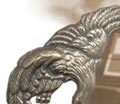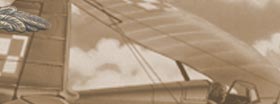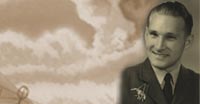Zenon, Stefan, Teofil Bartkowiak
1921 - 2002

Medals:
French: Combattant Cross, Resistance Volunteer Combattant Cross
Polish and British: 1939-1945 Star, Europe Star, Battle of the Atlantic medal, Defence
Medal, War Medal, Battle of Britain medal, Virtuti medal, Virtuti Military Cross with
4 bars, Silver Cross for Merit with two-edged sword, Air Force Medal with 3 bars.
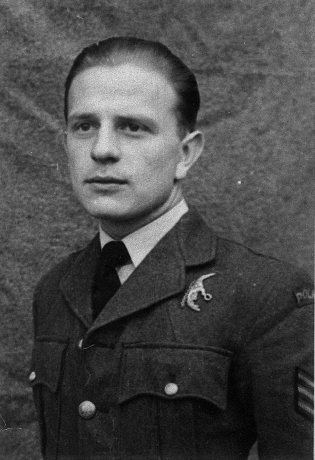
The following story has been kindly donated by Jan Bartkowiak. All copyright belongs to Jan Bartkowiak and permission is required for any part to be copied. The Bartkowiak family reserve all rights to these materials for any publication including electronic media.
The following story has a particular significance since Zenon Bartkowiak flew missions with my own father Zenon Krzeptowski when they were part of 303 Squadron in the latter stages of the war. Jan has been a great help in translation of web pages and finding materials or other sources of information and generally supporting the role of the website. Forever grateful.
Chapter 1
Introduction
The Boy
Like so many young Polish teenage youths, Zenon Stephan Teofil Bartkowiak found
himself in a most frightening, worrying and uncertain position when on 1 September
1939 Germany invaded HIS Poland. He had already been accepted into a military
flying school to be trained as a pilot but other than for taking a glider course he had
not by then acquired sufficient skills to use in the defence of his homeland. The only
way he was advised to do so by the authorities was to hurriedly leave to reach a
friendly country willing to continue his training so that he could later take up the fight
against those who had overrun his birthplace.
The Young Man
So he set course on an unknown and circuitous journey to reach France and then England. This entailed internment, several escapes and a hazardous trip across several seas before he could reach France, this he did on his 18th birthday and later arrived in England to join the Royal Air Force Despite the fact that he had to pass through
several foreign countries whose languages and customs he neither spoke nor understood, they did hasten his early experience to enable him to become a young man in a very short time period.
The Man
Along with many other young Polishmen with the same aim in life he had to come to terms with the rules and discipline of another country's military arm. This must have been extremely difficult for him to comprehend and assimilate in a short period. He also had to bide his time until an opportunity arose to prove he was worthy of consideration to become a pilot. This took much longer than he had hoped for, but he stuck to his ground crew duties initially assigned to him like a man.
The Trainee
When the opportunity did arise, he soon proved he was capable of becoming a pilot by taking and passing an elementary flying course in England that allowed him to be considered for further training.
The Advanced Student
This involved an advanced course that he undertook as part of the Commonwealth Air Training Plan on a Canadian airfield situated on the vast plains of Saskatchewan. Here almost 3 years after departing from his beloved Poland he achieved his reason for leaving. He proudly returned to England resplendent in his uniform that now possessed his pilot's wings above his breast pocket.
The Pilot
After a spell of flying with battle experienced pilots to gain operational knowledge and technique, he was considered sufficiently qualified to join an operational squadron.
The Squadron Pilot
At last he was in a position to fight and in June 1943 he had been selected to join the second Polish Air Force unit to be formed in England, No 303 Kosciuszko Squadron. This unique Squadron was already famous for its tremendous exploits that lead to its outstanding contribution to the winning of the Battle of Britain. A battle that changed
the course of the war.
He regularly flew with this Squadron on operations across France and the Low Countries in preparation for D-Day under an entirely different name for reasons of his own. Unfortunately he was shot down over Northern France shortly before that momentous day.
The Hidden Pilot
As he parachuted down German ground troops fired at him repeatedly but he was virtually snatched from under their noses by a member of the French underground resistance who became in his own words , "his wartime brother and best friend" . He and others, including a lovely young French girl named Raymonde, knew him only by his new first name "Charly'' and for 4 months they hid him from capture. Later "Charly" became his Christian name for the remainder of his life. When the Allies arrived he returned at once to join his Squadron in England.
The Squadron Pilot Again
So until the end of World War 2 he again participated in 303 Squadron's operations over Europe and was discharged in 1948 with many Polish, French and British decorations gained in the service with the PAF.
The Married Man
In March 1951 he was married in England to the lovely Raymonde who had helped to hide him in France. They had a son and later they all returned to Northern France where they settled down for the rest of their lives.
This is the Story of this Man
The remarkable life story of this man is based on several long letters that he wrote in English in 1994 telling of the time he was in hiding 50 years before. Also several recorded notes came to light of talks that he gave later in life. Surprisingly he left very little other information about himself, so a great deal of research had to be undertaken to complete this story. Much information was found in official records that detailed Zenon's wartime activity. Similarly, little detailed information has been found about Zenon's parent's lives in order to set the background to his own, although his father was known to be a time-serving Polish Army Officer. Both father and son fought in different theatres of war for their respective Polish units and were well decorated for their duties. However, it was more than sad that neither was able or wished to return to their homeland when hostilities had ceased after fighting for so long with this sole purpose in mind. There was no excuse for the injustice metered out by several different authorities after the war that prevented their return and perhaps Zenon's decision to settle in France as Charly, ameliorated to some extent what must have been bitterness and disappointment. Unfortunately his father never had the same opportunity.
This life history has been prepared jointly by his son (a French citizen also with British nationality) and an Englishman (who recorded the history of the airfield Zenon/Charly left when he was shot down). It is not only a tribute to the man himself, but it is also intended to be a record for his existing family today and for those who may follow.
Jan Bartkowiak
Chapter 2
Zenon's Young Years in Poland
His Place of Birth and his Family

Pleszew Family House (pre war)
Zenon Stefan Teofil Bartkowiak was born on 21 day of November 1921 in the town of Pleszew, about 30 km from the German border at that time. It was a small to medium size town with a long history. A large proportion of its surrounding land was arable although there were forests to both the southwest and northeast of the region.
His father was Jan Bartkowiak, born 6 July 1891 at Komorza, Jarocin, Poznan, Poland. He was a regular soldier in the Polish Army from 1919. When WW2 broke out he was believed to be a Warrant Officer in 70 Infantry Regiment who fought in the 1939 campaign in Poland. It is thought he might have been serving in eastern Poland when the Russian's invaded on 17 September 1939. Realising he would be shot if he was taken prisoner by the Soviets and found to be a Polish officer, it is said that he managed to change his uniform for one worn by a dead Polish soldier. He was deported to Russia and probably imprisoned in one of the many gulags (slave labour camps) where Russia placed most Poles that resisted the Red Army's 1939 invasion.
He was thought to have remained in one of these camps until after the signing of the Sikorski-Maisky (Polish-Soviet) agreement of 30 July 1941 after which he was released with others to join the Polish Armed Forces. He re-inlisted in the Polish Army on 1 September 1941 and travelled via Iran and Iraq to Palestine where he arrived on 13 May 1942. He served in 2 Polish Corps in the last 3 countries plus Egypt between 1942 and 1944 after which he saw much action in Italy including the fighting at Monte Cassino and the Battle for Bologna until 2 May 1945. He was finally discharged from the Polish Resettlement Corps in the UK on 5 March 1949. It is said that he became a school caretaker at Worksop in Nottinghamshire during the 1950s. He died in
Zenon's mother was named Malgorzata nee Kasprzak but little more is known of her background.
Zenon had one sister and one brother. It is said that his brother was caught by the Germans listening to an overseas programme on the radio that was an arrestable offence. When his mother was allowed to visit him he requested she bring him food when she next came. This she did but found he had been sent to Poznan and it is said he was later shot. His mother was also shot perhaps as a result of this incident or the Germans found out that her husband was a Polish Officer. His married sister was Janina Borkowska and it appears she also lived in Pleszew throughout the war, as her name and address is given in Zenon's service record as his next of kin. Presumably this would never have been used during the war when Zenon went missing for fear of a German reprisal against his sister.
Zenon Joins the Military Flying Training School
Little is known about Zenon's early life as presumably his father was away from home for much of the time. He obviously became proficient at his studies in order to aim for a career that demanded certain qualifications.
Unfortunately it is not known why Zenon decided to take up flying. Perhaps he was influenced by his father as a timeserving army officer, or he envied him being a military man and with the threat of Hitler wanting to spread Nazism into Poland, Zenon thought it was time for him to act to prevent this. In 1938, at the age of 16 he took the entrance examinations to attend the SPLdM, the NCO's Aviation Training School for Minors at Swiecie, about 160 km north of his hometown. Prospective candidates to this School had to be between the ages of 16 and 17 years and have at least a 7 year of primary school certificate. They had to attend two days of rigorous examinations, be physically fit and possess the recognised aptitude required by the Polish Air Force.
The original School was opened in Bydgoszcz in 1930, but the gathering storm clouds demanded an increase in the number of cadets and a new part of the School was opened in 1937 for first year cadets at Swiecie. The remainder of the School moved to a new location at Krosno in October 1938 that was situated in the south of the country.
His first year consisted of arduous military discipline including drill, better known as 'Square Bashing', physical training and formal learning of military regulations. His standard of education was also upgraded during the year to an intermediate matriculation level. By the end of that year the authorities could select those who would go forward for pilot training. Obviously Zenon was selected as along with other pilot candidates he was posted in 1939 to the military gliding camp at Ustianowa some 60 km southeast of Krosno and only a few km from the famous Bezmiechowa gliding establishment. It is presumed that most who took this course would have soloed and had reached their 'C' badge standard on completion. This type of initial training towards powered flight was of course cheaper and quicker. All were then posted to the main training School at Krosno, about 125 km southeast of Cracow and not far from the Czechoslovakia border.
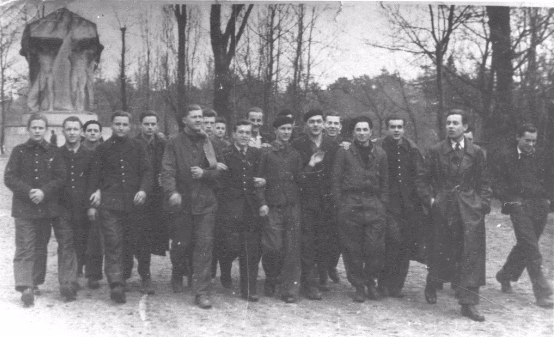
Parc de la Tete d'Or
by the war memorial in Lyon in January 1940.
The School at Swiecie was closed down in June 1939 due to its proximity to the German border and all sections of that School were transferred to Krosno. Due to the intense pressure to train more pilots and for safety reasons a satellite airfield was opened at Moderowka (known as Krosno Ill) at the end of July 1939 where Zenon is believed to have soloed before September, probably in a RWD 8 type aircraft. This airfield was about 20 km to the northwest of Krosno. During one of the summer camps in 1939 Zenon sustained an injury to his right elbow while taking part in an
athletic event. Exactly what happened isn't known but it left him with a scar that obviously warranted a remark on his service papers when he joined the RAF in 1940.
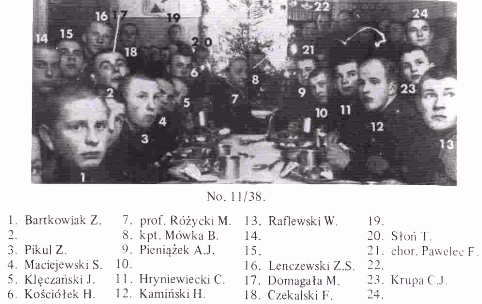
Krosno Christmas 1938 ‐ what happened to them during the war?
The School had to Close
At the time Germany invaded Poland on 1 September 1939 Zenon was a 17 year old cadet under training. From day one the German Luftwaffe launched divesting attacks on undefended Polish cities, against which most of the out-of-date aircraft flown by the Polish Air Force could do little to stop them despite their brave attempts to do so. This and the German blitzkrieg tactics adopted by its troops and armoured columns. led to a rapid advance into Poland. From the first day of the German onslaught the School's airfields were bombed not once but twice and it is reported that over 60 aircraft out of some 200 on the ground were destroyed and many others damaged. So the Polish Air Force had to quickly decide what action to take, as it was obvious the School could do little to defend itself or help the cause by staying. Far better to save the knowledge and skill of its fledgling pilots by encouraging them to escape to
England or France that had supposedly to come to Poland's aid through a guarantee made on 31 March 1939 should it be attacked. These countries could do little or anything at that point in time so Poland was left to its own devices. If these cadets and their instructors could reach either of these two friendly countries then hopefully they could assist them to complete their training and eventually regain their land by fighting Germany on equal terms. The authorities decided to order them to do just this, but had little idea how it should be achieved and what might lie in their path before they reached them.
Zenon says Goodbye to his Poland
The exact date when the School closed is not known though it would appear to have been before the 11th of that month as initially the cadets and instructors were told to proceed to the USSR, then almost 300 km to the east. When Russia decided to invade Poland on that day, the School then had to change direction and head for Romania. They travelled partly by coach and this means of transport was possibly lost when a German reconnaissance aircraft attacked the party, but luckily there were no serious casualties . During the attack Zenon's party tried to take cover in a potato field where he received a minor wound that he later said was from an anti-personnel bomb that failed to explode. It is said they had to march the remainder of the way. Unlike today, Poland and Romania had a common border at that time and Zenon found himself with his fellow cadets about to enter a country luckily not then under German control. It is
interesting to note that with the existence of today's borders, this escape directly into Romania would not have been possible. It is believed they passed over the border at Kuty.
Few of the cadets could have had any idea of what lie before them and whether any would become future pilots and so help remove those who had invaded their country without reason.
Chapter 3
Zenon's Escape to England
Internment
When the Cadets arrived at the Polish border, thought to be at Kuty, Romanian soldiers met them, any arms they were carrying were taken and all were automatically interned. They were placed on-board a train and transported to Slatina, about 140 km west of Bucharest where they were held in an artillery barracks that were reported to be rather run down and neglected. At this time, the Germans were not in control of Romania for the country tried to declare itself neutral however the fascist influence was becoming obvious and open. For on Thursday 21 September the Romanian Prime Minister Calinescu was shot dead. Fascist of the so-called 'Iron Guard' were captured and executed.
Escape
Some of Zenon's colleagues who were interned at Slatina spoke later of organizations in Romania that assisted Polish airmen, both there and at other locations where Polish military were interned. This allowed the Cadets to gain money and civilian clothes besides acquiring help in how to leave Romania. Most managed to escape internment either by bribery or the lack of strict supervision by the guards. Many headed for the Polish Embassy in Bucharest where their photographs were taken, passports were made and forged visas under assumed names were issued. From there, most made
directly for the Black Sea port of Balcik presumably because someone in the Polish Embassy or a pro-Polish organisation knew that a ship would call there that could take them to France.
Zenon for unknown reasons was not aware of this method for leaving Romania and instead tried to escape the guards at Slatina and make his own way out of the country. Unfortunately he never recorded how. At his first attempt he was soon found by Romanian soldiers who were not averse to firing a few shots at him. His recapture was probably helped by the fact that most of the Cadet airmen had shaven heads and looked more like convicts than Romanian civilians. He tried a second time to escape but this time he left with a colleague. With only the sun to guide them, as they had no
compass, they managed to walk without food for some 24 hours until yet again they were apprehended by soldiers. The third attempt was more successful and was partly aided by, as Zenon later related it, to the illiteracy and naiveté of the guards. Perhaps he gave them the impression that he and others would be back where they were held and hence the guards didn't go searching for them, for few understood the Polish language.
Zenon with a few other colleagues quickly made their way towards the nearest railway line. Shortly after reaching it, a slow moving goods train came into sight heading in the direction of Bucharest and as it slowed even more to take a bend, they managed to board it quite easily. Knowing that the German SS was said to be already in the Romanian capital in some numbers they all wisely alighted before reaching the city. Shortly after, they came across a car that they commandeered and promptly sold it to buy food. The excess cash they hid in their shoes but next morning after sleeping under the large eaves of an overhanging roof, they found their shoes were missing.
Undeterred they walked bare foot until they came to an inn where to their surprise they found it full of escaped internees. After eating once again they took a road to another railway line, found a passing train and gained a free lift as before.
Sometime later they came across a number of farmers talking beside the rail track so jumped off to determine where they were and where they should make for. After conversing in Bielorussian they obtained a ride in a horse-drawn wagon and after a lengthy 5 days walking they arrived at the small port of Balick near Varna on the Black Sea coast. During this time they fed as best they could by scavenging vegetables found in fields and taking fruit from orchards they passed by. Once again, they were taken aback at the port by the sight of a large number of escaped Polish prisoners they found around the harbour. Zenon imagined that he was once again in his homeland as there were so many conversing in the Polish language. He estimated there to be around 1600. The embarkation mainly took place at night by those with so called valid passports and exit visas. When aboard these documents were collected and sent ashore for use by those without them until all those waiting were eventually embarked on the Greek vessel SS "Patris" bound for France.

It is still a mystery how Zenon and his group knew where to head for unless they had heard about this possibility when they stopped at the inn or perhaps had met other pilots or cadets on the way who had prior knowledge. Whatever was the case, it was either very good information or remarkable luck.
The Sea Trip
It is difficult to imagine that some 1600 foreigners could be embarked aboard a modest vessel without raising suspicion. Surely the emigration officials would have become wary of repeatedly seeing Poles with the same passports and visas that were obviously forged, all going aboard the same ship. The emigration authorities at the port as well as the Captain of the "Patris" must have turned a blind eye to what was going on, or say, the Polish/French/English authorities connived to bring this about. Whoever arranged this or allowed it to happen, created a lifeline to freedom for all these Poles who accepted it without question. It was said the ship was a coaler, however from a photo of the "Patris" by Kopanski it does not appear to be a vessel with this type of cargo.
From photos on deck during the journey, published in "Skrzydla" (Nr141/627) by Franciszek Kornicki, the influx of all this additional human cargo had to find its own accommodation wherever it could on-board . Most preferred to stay on deck when the weather was fine during the first few days of the journey but as Franciszek Kornicki wrote later about his first night trying to sleep, his mind was full of what he had seen during his last days in Poland. Thoughts that many others aboard must have been anguishing about. He said he had "visions of his family, smoke rising from burning villages and towns as far as the eye could see, smashed and burned up aeroplanes, smouldering lorries and carts, dead horses and that never-to-be-forgotten hospital in Lodz, full of wounded and dying men, laying everywhere on beds and on the floors, in rooms and in the corridor, some moaning in agony, others lying silently with their eyes closed, or wide open, waiting and hoping." Perhaps Zenon was lucky enough not to have witnessed so many dreadful scenes for he is not reported to have mentioned them, though others who had might possibly have told him about them.
After passing through the Sea of Marmara and the Dardanelles a fierce storm raged for some 30 hours. Many could not stand the stench of whatever spot they had found below deck, as most were violently seasick throughout the storm. Some went on deck, but while the air was fresh there it became a nightmare feat just to hold on to something to prevent going overboard. It was so incredible that rumour had it that the captain and crew were standing by to abandon ship. Gradually the storm subsided and the remainder of the journey towards Malta was across a warm and smooth Mediterranean. However the drinking water and food ran out some days before it reached the island and six died and around 60 became ill. One report said the stock of wine on board had to replace water, but for a price that the Greek crew demanded. One could imagine what a large number of escaping internees thought of that. A British ship must have known about the passage of the SS "Patris" and the predicament of its human cargo as it was reported that it supplied it with tins of bully beef and water before it reached Malta.
Most Poles disembarked at Malta while a few remained on board while the ship restocked before completing its journey to Marseilles. They did so because they wished to reach France at the earliest opportunity and continue the fight. France had not of course at that time been invaded by Germany. Zenon along with many others preferred to sail from Malta in the 42,000 tonne ship the "Franconia" bound directly for England but in doing so in thick fog the ship collided with another of a similar class shortly after leaving. It returned to Malta for two weeks while repairs were
completed. When it did sail, its destination was changed to stop first at Marseilles where Zenon disembarked and was taken by bus to Lyons-Bron airport arriving there on his 18th birthday on 21 November 1939.
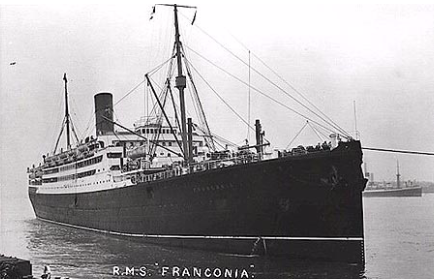
At Lyon he was given a French uniform, presumably, because he was originally a military cadet under training and not yet a qualified pilot. As France was supposedly to come to the aid of Poland, the French authorities assumed he would become a member of the French Army, but this was not to be, although there is no report of what Zenon thought about this.
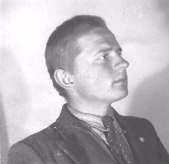
Zenon at Lyon-Bron 1940

Transfer sheet Lyon-Bron for Eastchurch
Chapter 4
Zenon Becomes a Qualified PAF Pilot
The Ground Training School
When Zenon became officially part of the RAF from 16 March 1940 he was at RAF Eastchurch. This airfield on the Isle of Sheppey off the southern shore at the mouth of the River Thames dates back to 1909. Here much of the very early days of civil flying in England took place and soon after this date it became a military airfield. Up to September 1939 it was in constant use by the RAF, but in December that year it became the destination for the arrival of exhausted and bewildered Polish ground crew. Here the Poles recuperated while being selected for equivalent RAF trades. Many required short conversion courses while others had to be completely retrained. Zenon was categorised as an Aircrafthand Second Class/General Duties, known, as an ACH2/GD. This was the first and lowest rank given to those unqualified in a trade or lacked a skill when first joining the RAF. This was understandable in Zenon's case as
he was still a cadet in training when in Poland with no doubt very few flying hours. Probably his greatest need at that time was to be trained in the RAF ways and rules before his future could be decided. In the month he arrived it is said there were about 1300 Poles at Eastchurch.
With the German rapid advance into France the RAF decided to move this establishment to Blackpool in Lancashire on the northwest coast of England, where it was deemed to be less likely to attack by the Luftwaffe. Here as part of No 3 Wing, Zenon remained from 29 May 1940 to the 1 July that year at what was classed as a Ground Training School that was initially an assembly and clearing centre for all new Polish airmen arriving in England. It is not known whether he became proficient at a given trade during this period or was mainly concerned with familiarizing himself with RAF discipline while waiting what he hoped would be further pilot training. Whatever it was he was no doubt extremely disappointed not to be able to continue with this training immediately, though there is no mention that he showed this.
RAF Bramcote
This airfield northeast of Coventry in Warwickshire was first opened on 4 June 1940 as part of RAF 6 Group and the day Zenon was posted there on 1 July that year the first of 4 Polish Bomber Squadrons was formed known as No 300 ("Masovian"). On 22 July No 301("Pomeranian") was formed and later, No 304 ("Silesian") and No 305 ("Ziemia Wielkopolska") came into being.
When 301 Squadron was formed flying single engine Fairey Battle light bombers, Zenon became part of its ground crew. Unfortunately his duties are not given in his records although there is one indication that he may have become an acting air gunner. The Battle's crew had a pilot, bomb aimer and rear gunner so he may well have acted as a gunner during the Squadron's flying training as before and at that early stage of the war many RAF ground crew acted in this dual role. However there is no evidence to suggest he acted in this capacity on active operations.
RAF Swinderby
Zenon remained with 301 Squadron when it moved on 28/29 August 1940, along with 300 Squadron, to RAF Swinderby, midway between Lincoln and Newark in Lincolnshire, as part of RAF 1 Group. Both were all Polish Squadrons and 301 was
Commanded by Colonel Roman Rudkowski.
Again Zenon's duties are not defined on any of his records but he was on the airfield when both Squadrons made their first Polish operational bomber raid from Britain against Boulogne harbour on 14 September 1940. This must have felt good to Zenon to be able to help in this attack just one year from the time he had to leave his homeland. He may also have been party to the plan to fit wailing sirens to the Squadron's Battles to remind the enemy of what the German Stuka dive bombers sound like on the ground when they rain down their bombs. This was of course wholly unofficial, but no one in the RAF tried to stop them. However on 13 October the Luftwaffe raided Swinderby dropping 6 bombs, damaging 2 Battles and injuring one airman.
During October and November 1940 both Squadrons converted to the twin engine Vickers Wellington. Zenon most probably was there when King George VI and Queen Elizabeth visited the airfield on 22 January 1941 during a period when both
Squadrons were repeatedly attacking Germany throughout its industrial Rhur and elsewhere. In December 1940, Zenon was promoted to an ACH2, one rung up the RAF promotional ladder.
One unusual feature of Zenon's time at Swinderby was that he was billeted with other ground-crew, away from the airfield. This was sometimes necessary especially on a new airfield before nearby billets had been built. He was placed with a family in Lincoln where the husband was away in the army. The name of the family was Armiger, a name that became of some significance to Zenon in a few years time. It is said that he became like a son to Mrs Armiger who he kept in contact with for many years after the war.
No 12 Initial Training Wing
ITWs were set up to determine whether recruits were likely to be physically and mentally fit to become aircrew. Normally a recruit would have previously been medically examined and taken an initial aptitude test so ITWs could concentrate on the training of navigation, meteorology, aerodynamics, engines and signals. But foot-drill was not forgotten and nor was physical training, all necessary subjects for potential aircrew members.
It is not known whether Zenon had pestered the authorities to continue training to become a qualified pilot, or he was told to wait his time for an opening on one of the normal RAF training courses such as an ITW. Whatever might have been the case he joined No 12 ITW at St Andrews in Fife Scotland on 19 July 1941 and remained there for almost two months. Much of the course was probably familiar to Zenon, as he must have learned much of the basics in Poland prior to September 1939. If as was probable he was told this was the only way he could become a RAF pilot, then in
service parlance "he had to grin and bear it".
No 15 Elementary Flying Training School
At last Zenon was back to flying again for he was posted on 12 September 1941 to join the 23rd course at No 15 EFTS at Kingstown, just 2 miles north of Carlisle, in Cumberland, now Cumbria, during a period when the School was extremely busy. Due to this and the poor drainage at Kingstown, two nearby Relief Landing Grounds were constructed, one at Burnfoot and the other at Kirkpatrick. It is however not known whether Zenon used either of these RLGs.
By 31 December 1941, Zenon had been promoted to a Leading Aircraftman with his records showing his trade to be a ACH/Pilot, though it would have been more appropriate to have been called a Pilot under training.
Early in 1942 the Miles Magister training aircraft, used by the School was replaced by the De Havilland Tiger Moth and a Polish Flight was formed that Zenon presumably joined. The type of training also changed around this time from full ab-initio to flying grading. In the former, students were given some 40 or so hours of flying where many might be flown solo, whereas in the latter only around 12 hours instruction was given. This was considered sufficient to allow students to solo and be judged if they were suitable for further instruction at an overseas School and so save time and money. Obviously Zenon reached the required grading level although his service records show that he remained at Kingstown for almost 4 months that is quite a long time to complete just 12 hours instructional flying time. Perhaps he, along with other Polish students who had some previous flying experience might have completed the full EFTS course, as he later went straight to a Service Flying Training School when he arrived in Canada, rather than completing the EFTS course as did those who were judged suitable at the end of their grading.
At the end of EFTS all students were recommended to become either fighter or bomber pilots. Fighter pilots would go forward to fly single engine aircraft while bomber pilots flew twins. Zenon was obviously recommended to fly single engine aircraft.
The fact that Zenon went to 15 EFTS can in hindsight be considered rather ironic. No 15 EFTS was originally formed as a Reserve Flying School at Redhill Airfield in Surrey in July 1937. At the outbreak of war it became an EFTS and was moved with its Magisters to Kingstown to a safer area for training. In December 1943, RAF Redhill became the parent airfield for the administration of the Advanced Landing Ground at Horne, less than 7 km away, where Zenon would be based in April and May 1944
No 28 EFTS Wolverhampton
Zenon left Kingstown on 17 January 1942 and arrived the same day at Wolverhampton in the West Midlands until the 2 March 1942. The reason why he was posted to another EFTS is not clear although one of his service records suggests that he was part of a Pupils Pilots Pool, presumably to await his next stage of his training overseas.
Aircrew Dispatch Centre
From Wolverhampton he spent a further 10 days at this Centre in nearby Heaton Park at Manchester before setting off on 13 March 1942 from presumably Liverpool Docks for his training in Canada.
31st PD Moncton New Brunswick
(The PD was thought to stand for Pilot Depot.) Zenon arrived here on 27 March and therefore took 14 days to cross the North Atlantic that suggests his ship was part of a slow moving convoy that zig-zagged its way over. Zenon never recorded what the trip was like as storms at that time of the year could be treacherous and enemy U Boats had learned how to hunt in packs by 1942 and many allied ships were sent to the bottom

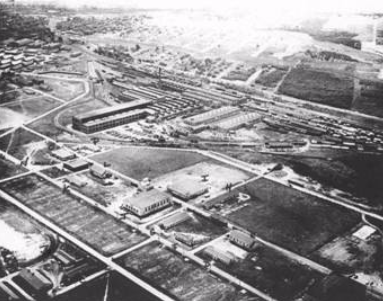
Many airmen that had been selected for aircrew were regularly taken across by the massive 85,000 tonne Queen Elizabeth Cunard liner that was impressed into carrying some 24,000 service personnel on each trip from the time she was launched in 1940. She was so fast that she had no need of protection and sailed by herself rather than in convoy. Others had to make the journey in whatever space was available in any ship that was allocated. Some of course were lost through U-Boat sinkings and many aircrew lost their lives, like the Danish ship Amerika that had sailed from Halifax in 1943 with 53 trained aircrew aboard on its way back to England. It was torpedoed and only sixteen airmen survived.
Zenon remained at Moncton for 4 days before taking the long train ride across most of Canada to the SFTS where he arrived some 5 days later on 4 April 1942.
No 39 Service Flying Training School, Swift Current, Saskatchewan Canada
This SFTS opened in December 1941 and was part of a massive training programme under the British Commonwealth Air Training Plan that came into being in June 1940. This plan allowed training to be undertaken away from the UK where its airfields and skilled instructors were wanted for operational duties and enemy activity could not interfere with training schedules.
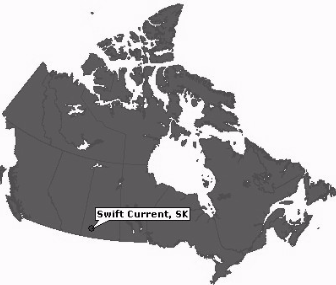
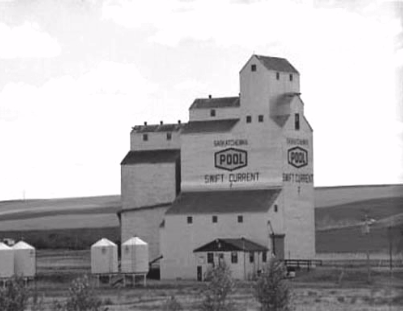
The airfield was set within the start of the rolling foothills of the Rockies and Zenon had obviously arrived at the right time of the year because the harsh Canadian winter was almost over as he was thought to have arrived on 13 March 1942. The main part of his training programme would therefore have run into the normally hot summer experienced there. He was obviously there when the following report appeared in the Swift Current Sun newspaper for April 7 1942:-
Interesting Group of Airman Arrive
A group of nearly three score men, a veritable League of Nations, arrived here Friday for No.39 S.F.T.S., of the R.A.F. Among them were Czechs, Poles, Belgians, Norwegians, Free French and British. Some of the Free French in their natty blue and gold uniforms were at the Hospital Aid Dance in Elks hall last night. Among the men who came here are a lot who have had war experiences of interest, some wearing decorations. When they stopped at Moncton N.B., en route, a Free French officer told the Sun, they were told: "Going to be stationed at Swift Current? Your lucky, that's supposed to be a very friendly place." They had an uneventful crossing in a convoy and say: "Others will be following us".
Graduates from EFTS had learned to taxi, take off, climb, fly straight and level, descend and land without difficulty. They had also been taught aerobatics, spins and recovery, as well as low-level flying, instrument flying, night flying and cross-country navigation. SFTSs were created to transfer these skills to more powerful and sophisticated aircraft and Zenon with other students' flew the American designed North American Harvard trainer to gain this experience.
This two-seater aircraft, although possessing one or two undesirable flying characteristics, was recognized to be a fine training aircraft with features akin to the larger and faster Spitfire and Hurricane fighters that students would later fly. These features included a retractable undercarriage, flaps and engine controls. It had a 600 hp Pratt & Whitney Wasp engine and had a most distinctive note on take off due to the high tip speed of the direct drive propeller, commonly known as the airscrew.
Zenon flew this type of aircraft throughout his time at this School over a period of 5 months according to the demand for fighter pilots at that time and the weather. He would have probably amassed a total of over 100 hours flying by the time he graduated and received his wings. Much of the flying at the SFTS would be solo and he would have been sent on long cross-country trips to test his ability to navigate on his own. The countryside for hundreds of miles around Swift Current was comparatively featureless with very few roads, tracks or railway lines for guidance. The few main features of this vast open farmland included tall wooden grain elevators and most had the name of their location painted on them in large letters. Many a lone flier relying on his own navigation found he was way out from where he should have been when he arrived overhead and read the name.
Zenon's service record shows that he officially became a pilot in the RAF/PAF on 14 August 1942, presumably the day he was presented with his wings at Swift Current, at the age of 21 years. By the 18 August 1942 he had returned to 31st PD at Moncton in readiness to return to the UK.
The Polish Depot Blackpool
He arrived at No 3 Personnel Reception Centre in the UK by 11 September 1942 and again no information exists to describe what the return Atlantic journey was like or what vessel he sailed in. By the 30th of that month he took up residence at the PAF depot where he remained for some 4 months. He most probably undertook various courses that might have involved flying, but this would not have been at Blackpool as there was no airfield there. If he was not occupied in this manner then it seems that an awful long time was wasted before he could complete the full course that would prepare him to join an operational squadron.
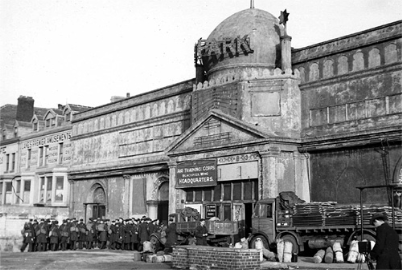
On 31 December 1942 he was promoted to a Sergeant Pilot.
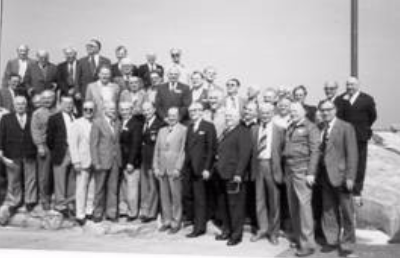
Veterans' reunion Blackpool.
No 5 (Polish) Advanced Flying Unit
This Unit was stationed at RAF Ternhill, 5 km southwest of Market Drayton in Shropshire. Hawker Hurricanes and Miles Masters were used by the Unit with a large preponderance of the latter. 4 nearby satellite airfields were also used because of the large number of training aircraft stationed there. The Hurricane provided experience on what was still a front line type of fighter. However the Master was considered to be inferior to the Harvard as a trainer but as there were so many of this British designed aircraft still serviceable they had to be used. Despite this both aircraft were used to teach advanced flying techniques.
Zenon was stationed at this unit for only about 5 weeks from 9 February 1943.
No 58 Operational Training Unit.
The airfield on which the OTU was situated was a km south of Grangemouth in Falkirk, Scotland, near the south bank of the Firth of Forth. Zenon arrived there on 16 March 1943 to fly Spitfire MKI and MKlls'. Most Polish fighter pilots trained at this unit before being posted to operational Squadrons. It intentionally exposed pilots to the type of flying expected of them in front line Squadrons. It included much formation and combat exercises as well as gunnery practice.
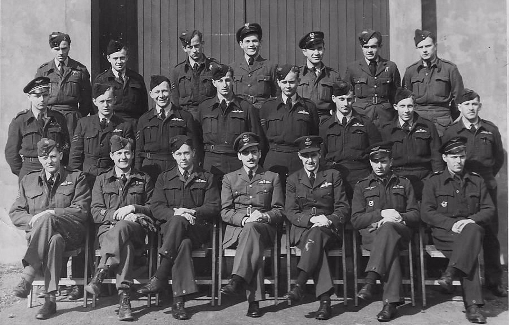
- 2nd Row at first left: Georges Albert GIRARD († 16/12/1944 "341 Squadron")
- 1st Row at first right: Daniel Paul Eugène FRY († missing 17/03/1944 "341 Squadron")
- 1st Row at 2nd right: Bernard Adrien PÉRAUX († 05/09/1943 "11 AFTS")
- 3rd Row at 2nd left: Ernest Louis LE GOFF († missing 20/11/1948 "GT 2/62")
Part of Zenon's flying training here might have taken place at Balado Bridge a satellite of Grangemouth, about 15 km northeast. This was thought to experience better weather conditions than those on the banks of the Firth of Forth.
By June 1943, Zenon was at last considered to be a fully qualified RAF pilot ready to join a Polish operational Squadron and therefore a pilot of the PAF.
So at the age of just over 21 years, Zenon had achieved his purpose for fleeing his beloved Poland and more importantly he had become a member of his country's Air Force, albeit stationed in another country, to fight those who had invaded his land.

Chapter 5
303 (Kosciuszko) Squadron
RAF Northolt
On the 1 June 1943, Zenon passed through the main gate at RAF Northolt only 9 km from the centre of London to become a pilot of that famous Squadron. It was formed on this airfield on 2 August 1940 at the start of the Battle of Britain and became the 2nd Polish fighter Squadron of the PAF and the first to see action. Within a period of 3 months it proved itself by becoming the highest scoring Squadron in the RAF during the battle. Zenon must have been extremely proud to be posted to this renowned Squadron. Captain Witomar Bienkowski was then the CO.
After completing all the normal joining routine and familiarisation flights as a new boy to make sure that he could recognize the area in which Northolt was situated, his records show that he undertook his first serious flight on 13 June 1943 to take part in a rescue mission off Dungeness on the south coast. It lasted 1 hour 20 minutes and presumably entailed searching for a pilot downed in the English Channel. During that month, Zenon took part in 5 more similar missions in the same area off the south-coast.
During this month of June the Squadron exchanged its Spitfire VB for the mark IXC. This new mark was an improved version of the VB with a Merlin 61 engine and a four-bladed propeller the aircraft was developed specifically to combat the Luftwaffes' successful Focke Wulf 190 fighter that outclassed the VB.
On the 2 July 1943, Zenon found himself taking part in his first operational sortie, the type of which he would become very familiar with in the coming months, known as a Ramrod. As previously explained, this was the operational code word for a discrete bombing raid to destroy a specific target with fighter escort, with 303 Squadron this time providing the escort. The target was Pavilly, north of Rauen in northern France, his flying time was 1 hour 35 minutes, but no details of the actual target or how the operation went were given in his records. The following day Captain Jan Falkowski became the CO of the Squadron.
By the end of July, Zenon had participated in 10 Ramrods and 7 rescues totalling almost 17 hours flying time and by then he most probably no longer considered himself to be a new boy. He was again on some 7 similar missions during August but did not take part in the support for the unsuccessful landings at Dieppe on 19 August when some 62 other fighter Squadrons participated. However he did undertake his first fighter sweep, code named a Rodeo, on 28 August in the Le Touquet area. This was where many of the front line German fighters were once stationed, commonly called the "Abberville Kids", but by this period of 1943 as mentioned earlier, most had been withdrawn nearer to the Fatherland for protection from frequent raids by large formations of USAAF daylight bombers. Such fighter sweeps could consist of up to 36 Spitfires flying together sometimes all in line abreast, either to entice German fighters aloft to fight, or to attack their airfields as well as targets of opportunity. Unfortunately again there are no records as to what happened on Zenon's first sweep.
This might not of course have been his first sweep as sometimes when the escorted bombers were returning home and there was no intelligence that German fighters were in the area, then the Wing or Squadron Leader would be granted permission to leave the bombers and carry out a low-level sweep. On other raids 303 Squadron acted as an advanced sweep to ensure that no enemy fighters would be in the vicinity when the bombers arrived within the target area. One such sweep preceded 36 Marauders on Ramrod 187 on 4 August 1943. Zenon in Spitfire BS 451 was one of 11 aircraft of 303 Squadron along with 316 Squadron. They arrived over Etretat at 19.17 hrs at 26,000 ft and made a dive to the south and then over the Seine estuary. Having been warned of enemy aircraft over Bernay they could not find any so turned NE and were again warned of aircraft over South Rouen but again could not find them, so came home.
Spitfire XIC aircraft flown by Zenon during this period included:-
BS 513 on 2 August.
BS 451 on 4 August
BS 451 on 8 August
BS 506 on 27 August
BS 180 on 31 August
The 23 August 1943 was a memorable day for Zenon because General Sonskowski the C in C of the Polish Armed Forces in succession to the late General Sikorski (killed in Liberator crash off Gibraltar 4/5 July 1943) visited the Polish Wing at Northolt
September 1943 for Zenon mainly consisted of about 10 further Ramrods and so did October, so by 7 November Zenon had amassed almost 57 hours flying time with 303 Squadron. By this month, the Squadron had been operating in front line duties for over 3 years with very few periods of rest in between, so the authorities decided to move it for a spell on the 1ih of the month to RAF Ballyhalbert in Northern Ireland.
RAF Ballyhalbert
Ballyhalbert was located half way along a narrow isthmus-like neck of land that jutted out into the Irish Sea about 20 km south of Belfast. 303 Squadron moved without its aircraft as it took over the LF Mark VB Spitfires left by 315 Squadron when it vacated Ballyhalbert. This mark of Spitfire was a low level version of the VB 303 Squadron formerly had when at Northolt prior to June 1943. It was similar to this aircraft but had clipped wings to enhance performance at low-level as explained in Chapter 2. A few days after the Squadron arrived, Captain Tadeusz Koc DFC became the CO on the 20 November. It was claimed that he was the last Polish pilot to have shot down a German aircraft before hostilities in Poland ended in October 1939.
Patrols
Obviously Zenon took part in some of the convoy patrols the Squadron mounted while at this airfield by the flying hours listed in his service records. Some were to the northeast of Belfast and others were over the North Channel between Ireland and the mainland escorting ferrying flights from the USA. On one or two occasions USAAF Fortresses were lost through lack of understanding of signals made to American pilots to follow 303 Squadron aircraft.
Witnessing the loss of a Squadron Pilot
On 1 February 1944 Zenon wrote a report about the loss of F/0 Podobinski flying Spitfire EN 586 because he was the last person to see him alive on 14 December 1943. The two of them had to return from an airfield at Toome on the northwestern shore of Lough Neagh, some 70 km northwest of Ballyhalbert. Zenon had to collect an aircraft for his S/Ldr as his was unserviceable. At this point in Zenon's report it is unclear how he travelled to Toome and the same remark applies to F/0 Podobinski. Perhaps they flew together in say, a twin-engined communication aircraft. Although
this airfield was primarily used by the USAAF, Zenon says that both 303 Squadron pilots' Spitfires had not been repaired that day 13 December, so they had to stay the night. This suggests that Toome had a major maintenance section that was not available at Ballyhalbert, hence the reason for their visit though this cannot be confirmed as Ballyhalbert was a normal 3-runway standard RAF wartime airfield.
The weather next morning was bad and they were not cleared for take-off before midday. Before doing so they agreed to fly together under the cloud base with the F/0 leading but subsequently Zenon found he had changed his mind when airborne and had climbed above cloud to some 4000 ft. Podobinski called up ground control and while it could hear and answer him, he could not hear control despite repeated attempts to do so. Control then asked Zenon if he could make contact with the F/0, but his gestures indicated that he could not. Zenon estimated that they were some 15 minutes flying time to Ballyhalbert and on contacting control he was informed they were some 5 miles east of the airfield. Zenon then tried to direct Podobinski to follow him by flying in front and across his nose, but he would have nothing to do with it. Perhaps as Zenon said "he didn't wish to obey a subaltern". Eventually he agreed to descend but after two attempts at having to rapidly climb to miss high ground as they came out of cloud, Zenon lost sight of the F/O's aircraft and sought the help of ground control who vectored him to a point where he could descend safely and land.
The weather for the next 3 days was extremely bad and prevented any meaningful rescue flights. On the 4th day a crash site was located on the Isle of Man that proved to be the F/O's aircraft. While this seems a meaningless loss, the question must be asked, 2 "why did he continue to fly on his course for so long? As said above, Toome to Ballyhalbert is about 70 km apart, and Ballyhalbert to the Isle of Man is about a further 50 km, all 3 locations being in an almost straight line. He would have known within a few minutes how long it would have taken to reach Ballyhalbert so why not have made a slow descent on the same course when he thought he was over it until he was either below cloud or over the sea? If he had then flown on a reciprocal course he should have been over land where he might have been able to find the airfield or belly land. One other explanation might have been that something more catastrophic had taken place in the cockpit, be it medical or technical.
See The official statement made by Zenon on the loss of Podobinski
The Squadron is Recognised
Squadron Leader Koc represented 303 Squadron at a luncheon held at the Grand Central Hotel, Belfast on Wednesday 26 January 1944 at the request of the Prime Minister of Northern Ireland. The occasion was at his wish to meet representatives of the Allied Forces in Northern Ireland.
Training to Deck Land
Zenon must have flown more hours than were officially listed. For example he has written at some length about the naval pilots who instructed him and other 303 pilots to land on a marked out aircraft carrier. He maintained this was to provide experience for landing in a confined space at night. However, the question must be asked if they were intentionally being trained to use an aircraft carrier while in transit to another wartime front? They used markings on a runway laid out to represent the size and length of an actual carrier. One of the naval pilots stood on the left-hand side of the markings when on the approach and with a bat in each hand signalled to the pilot whether he was too high, too low, to one side, or one wing low, etc. At first sight Zenon and his co-pilots thought it quite impossible to land within this restricted area and told his naval instructors so. To prove that it could be done, the two naval pilots flew one of 303's Spitfires and on every landing made it look so simple. By the end of 10 days practice Zenon and other pilots of 303 Squadron were able to achieve this feat on almost every occasion. They then trained to do this at night with the aid of coloured approach lights. By the end of these training exercises they had become very competent and as Zenon put it, "I really enjoyed the accomplishment".
Restless
Although the Squadron had been posted at Ballyhalbert for an intended rest period it did not seem like that to its pilots as month after month went by. Stationed there during the cold and wet winter of 1943/44, most were more than keen to be back on operations in the south of England. It was most obvious that the invasion of France would take place in the coming months and they all wanted to be part of it. Zenon forcibly expressed his thoughts on this topic well after the war in various letters.
During the first 4 months of 1944, Zenon had only 3 official flights listed in his records, though of course there were no doubt several training flights that were not recorded, or perhaps very bad weather had curtailed flying to a large extent in that location. Morale towards the end of April was likely to have been somewhat low when orders to move back to the mainland were at last received. Not only that, the Squadron was to be based south of London where the action would take place perhaps both before and after D-Day. No one appeared to be concerned that they were going
to an Advanced Landing Ground that implied living under canvas they just wanted to be away from Northern Ireland, back to operational activity and the recreational high-spots of London.
So by Sunday 30 April 1944 all was packed and 303 Squadron was on its way south back to the mainland and action. Zenon was one of the pilots who flew an aircraft southwards.
Advanced Landing Ground at RAF Horne
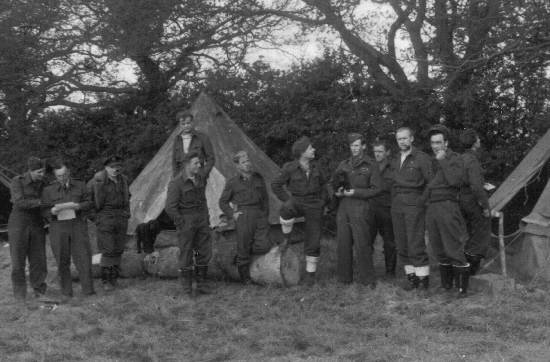
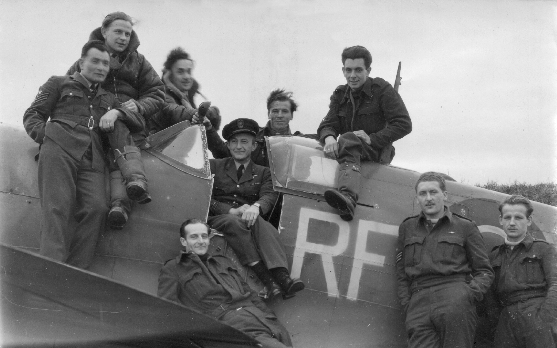
It was a bright spring-like morning when the Squadron landed at familiar RAF Northolt to refuel and have a bite to eat before proceeding on a 20 minute flight to the southeast of RAF Redhill. Soon the Squadron was in formation over what looked like a giant X that marked out the two metaled grass runways of ALG Horne set in farmland in southeast Surrey. Six young Air Training Corps cadets and the pilot of a De Havilland Dominie on a local flight unintentionally witnessed this scene from above as the Spitfires peeled off and made a stream landing one after the other, one of which Zenon must have been flying. One of those young ATC cadets still remembers that scene very clearly.
The official Ministry plan for the airfield indicated where the tented sites should be located but these were never adhered to, probably because the aircrew of the 3 Squadrons who arrived that day, had their say (See Chapter 2). Instead of placing them well away from the 2 runways as planned the aircrew erected them close by so the distance from each pilots' tent to his parked aircraft was extremely short. Each Squadrons' pilots and ground crew grouped themselves close together but separate from the other two.
Conditions on the ALG were purposely basic to expose both air and ground crews to what it might be like if and when they had to operate on mainland Europe. Several pilots found sleeping like this very unpleasant especially when the temperature fell below freezing. So another use for daily newspapers was quickly found to separate ones body from the earth. Besides living under canvas, ablutions consisted of washing in canvas sinks and baths using cold water. Breaking the ice in order to shave was another unwelcomed exercise.
The 3 Squadrons that formed 142 Wing at Horne were placed under the Air Defence of Great Britain instead of the 2nd Tactical Air Force that was responsible for air operations before, during and after the invasion of Europe.
After just one day to settle in, the Wing was on its 1st Ramrod early on Tuesday 2 May 1944 even though it was part of the ADGB rather than the 2nd TAF. It was a mark of their flying skills and efficiency that the 3 different Squadrons could fly on an operation for the first time within two days of coming together. However, Zenon did not take part on this occasion but he was on one of the patrols next day. The Wing regularly mounted dawn and dusk patrols over 2 areas. One was around the North Foreland near the southeast mouth of the River Thames and the other over the Solent, to the northwest of the Isle of Wight, two important areas to prevent enemy raids during the build up to D‐Day. However as one pilot said "We were never trained to fight at those hours of the day and the Spitfire was not the right aircraft to do so in any case!". This pilot was right as the Spitfire possessed no form of radar and had to rely on a ground controller to vector him to the vicinity of an unidentified aircraft. By this time of the war it had been proved that the most difficult part of a night-time interception was closing in from the last 500 km and this was virtually impossible without electronic aids.
Patrols and Ramrods with sweeps became the main activity of the 3 Squadrons throughout May. Up to 21 of that month Zenon had participated in 7 operations without any known incidents. However other members in 303 Squadron were not so
lucky. Several either brought back damaged aircraft or they lost their tail-wheels on landing due to the start of the runway steel mesh curling up. F/0 Zbigniew Marszalek on a local familiarization flight soon after he arrived, crashed into the ground at Nutley in Sussex, for no apparent reason and was killed. The 21 May was a black day for the Wing, 3 Spitfires were shot down and their pilots taken prisoner while 4 other Spitfires were badly damaged, all it is believed as the result of a low-level sweep after the Ramrod. One taken prisoner was F/Lt Stanislaw Brzeski one of the original Polish pilots in the Battle of Britain who had been credited with shooting down 8% enemy aircraft. This equalled the record of F/Lt Eugeniusz Szaposznikow who was also in the Battle and still with 303 Squadron.
The work was hard, tiring and dangerous particularly having to take off and land in darkness for the dawn and dusk patrols. Zenon believed that without the carrier training at Ballyhalbert, he for one could never have undertaken these patrols with the confidence he then had and often he felt a certain buzz having completed such a flight. However, the living conditions on the airfield did little to compensate at the end of the day's flying in contrast to most of his previous postings. The only thing that made up for this was the closeness of Horne to London where various cinemas, theatres, clubs and bars could be visited one after another. Full use of 24 and 48 hour passes were made in this way, especially by Zenon. In one of his later letters he indicated he had just returned from a weekend in London on Monday 22 May and found he was not on operations that day. Later he heard that another 303 pilot who was, had not returned from his weekend and when Ramrod 909 had been ordered late that day, Zenon was listed to take his place. Not only that, Zenon had to use his aircraft, EN 836 instead of his own. And so Zenon's fate was sealed that day though of course he had no idea what it would lead to.
Chapter 6
Shot Down and In Hiding
It was Zenon's Lucky day
It just so happened that the 22 May 1944 was the day of an important religious event held annually in France, when families and close friends celebrated their children's first communion. Besides the communion, it usually included a party with a large meal, much wine and jollifications that continue well into the night. Even though it was wartime, a party was still underway by early evening as Zenon was deciding how he should abandon his stricken plane high above. At that precise moment one of the guests named Michel Salmon, decided to stretch his legs outside and as he did so a noise made him look skywards towards an aircraft in trouble trailing smoke and falling rapidly to earth. Close to it was the pilot that had just taken to his parachute and was dangling beneath it while swinging from side to side in an attempt to avoid bullets being fired by German soldiers some distance away. Within the next second or two the plane had crashed not too far away from where the pilot was likely to land thought Michel. With his strong connections with the wartime underground movement in France he realized at once that there was every chance of him reaching the pilot before the Germans could if he had some means of transport. Looking around he spotted a ladies bicycle leaning against the side of the house, grabbed it and sped at brake neck speed towards where he imagined the pilot would land. He was not wrong and after finally struggling to pedal across a beat field arrived breathless to find Zenon in a collapsed state cuddling his parachute after his heavy landing.
If Zenon had been shot down on any other day, then he most likely would have been taken prisoner and the rest of his life would have been extremely different.
Whisked from under the German Noses
Zenon sat severely winded from his hard landing in this field somewhere in France with no idea of exactly where he was. His first task was to bundle up his parachute in his arms that he did still sitting on the ground to recover from the shock of his hazardous descent and heavy landing, glad to still be in one piece despite being shot at on the way down. Before he could think what to do next the young paleface man with his lady's bicycle was standing over him breathing heavily in his race to reach him first. Zenon's first words were in very broken French, "Anglais, Anglais. To confirm this he immediately pulled his identity disc from around his neck, it gave his name as Charly Armiger and not Zenon Bartkowiak. The young man knew that the Germans were not averse to dropping one of their own personnel in RAF uniform to find out who would help them. He also knew that many loyal French men and women had been caught in that way and along with their families were not seen again. Having established that he really was a RAF pilot, the young man felt him all over to ensure that he had no broken bones and could stand up to make a rapid getaway. Meanwhile many children had followed the young man across the field and were standing to watch what was going on. Some obviously knew the young man as they called him Michel, so Charly at least then knew his first name. Michel of course also knew Zenon's adopted first name by which he would continue to be known by everybody that he came into contact in France for the rest of his life.
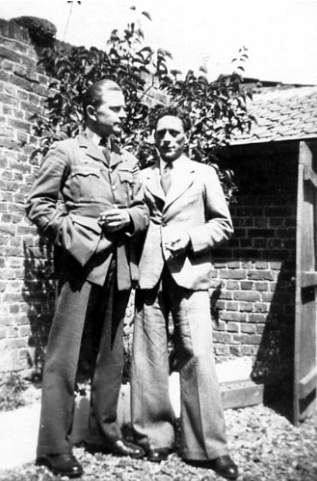
Zenon with his rescuer 1946
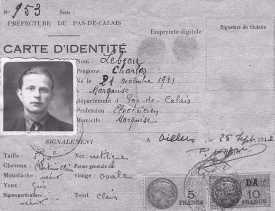
Forged ID card
Michel removed his blouse-like coat and signalled to Charly to put it on. All that Charly wanted at this point was to know where the Germans were? Michel indicated they were in the opposite direction to where he was hurriedly trying to take him towards some bushes at the side of the field. After passing into the next field full of rape, almost at the double, they descended into a shallow ravine known locally as "Le fonds de la noix", or "The bottom of the nut". Here they had to pause for a while as Charly was completely out of breath from the pace Michel had insisted they should move at. During the short stop, Charly took his knife out to cut off the tops of his flying boots to appear that he was wearing ordinary shoes. After burying the tops under bushes with presumably his parachute nearby, they hurried still farther for about one and a half kilometres. This gave the impression they were making towards the woods that Charly had seen on his way down. But Michel changed direction several times, once to divert the children who persisted in following them, once because he took a wrong turning and the last time to turn away from the woods towards the village of Camblain Chatelain. Shortly after, they came across a farmer's pitchfork beside the path and Michel quick minded gave it to Charly and told him how to carry it. This was to give the impression to anyone who saw them of two farm labourers returning home from a hard days work in the fields, as it was after all, well into the evening by then. Every German searching for the downed pilot would have obviously imagined he would head for the woods and no doubt the children confirmed this when questioned, as none would consider them foolish enough to head for the village. In any case it was only the last 60 metres or so that they were visible to others where they had to cross a single track railway line and pass through a cemetery before they arrived in some ones back garden where Michel was known to frequent.
The First Hiding Place
Inside the house was an elderly man sitting at a table in the kitchen eating who became very concerned when he realised what Michel had done. Angry words were exchanged and Charly thought his liberty had come to an immediate end. He had no idea what happened after this as he passed out, partly from the pain he had experienced in the landing and no doubt partly from shock that now set in. When he eventually came too an elderly lady had joined the group and a heated discussion was taking place. While this was in full flow and totally incoherent to Charly, he instinctively reached into his pocket to take out an English cigarette that he lit up. This brought the conversation to an abrupt halt. Michel immediately rushed over in panic, ripped the cigarette from Charly's mouth, removed the packet from his hand and threw both into the fire. He rapidly explained that such cigarettes had a most distinctive smell compared to normal French-made cigarettes that others could easily recognise including Germans. Charly learned later that the two elderly residents who were in effect Michel's adopted parents, were angry mainly because he had not retrieved the parachute. When this was later found, the number of bullet holes were counted before pieces of the silk canopy were shared among the villagers. It was found to be 44! It was a wonder the canopy had not split apart before he had reached the ground, after all that was one of the purposes of the Germans gunners because it was an easier target than trying to hit the pilot swinging beneath. Both were of course not allowed under the Geneva Convention. This might have caused him to descend faster than normal and why it made his impact with the ground that much heavier.
The foreign currency that Charly carried on all flights over enemy territory was also given to his rescuers for safekeeping. It included British, French, Belgian and Spanish notes issued to gain possible aid to escape. His stomach was still not right for he vomited badly after drinking a most welcome cup of coffee. Nevertheless he had to be found a safe house for the night and he was asked if he could ride a bicycle. After donning other French workers clothing given by the elderly man, the two of them rode across to the other side of the village to Michel's own house where he spent the first night.
Before doing so, Michel started to cook them a meal. He had obtained some ham from the black market and wanted to fry chips to go with it but as the fire had not been lit for some time the kitchen soon became full of smoke. Despite Michel's persistence Charly recalled that the meal was however not very tasty partly because he was still suffering from his heavy landing and partly from the effects of delayed shock.
The German Search
The Germans arrived in three armed motorcycle sidecars to the spot where Charly had landed some 15 minutes previously. They vigorously searched the immediate area and the nearby woods for several days before deciding to widen the search to include the village, as they had no clues as to where the fallen pilot might be hiding. Michel a
widower, was at the time courting a nearby widowed school teacher named Genevieve who had two young girls named Paula and Jacqueline who were to become the eyes and ears for Charly. Suspecting that the Germans would start to search the
village, Michel hid Charley in the local cemetery in a vault where bodies were held before burial. He was first taken there in the dark so he had no idea who he was sharing his hiding place with until it was daylight. Michel stayed with him during the first night there but had to depart around 4.30 am before dawn so as not to be spotted during curfew hours returning to his own house before reporting for work at the local coal mine. Charly recalled later how scared he was when left alone especially when he realised there were two bodies alongside him in the vault awaiting burial. One had a well‐made suit on that he estimated would fit him perfectly but he was too nervous to take advantage of it.
Later that afternoon Michel appeared looking very dirty and grimy from his shift at the mine to say that he would go home to wash and return later with some food. This he did with two slices of fresh bread and cheese as miners received increased rations from those of ordinary workers. Alas, Charly's stomach had not yet settled enough for him to enjoy it, but he did rejoice to have company once again.
When not working at the pit during an afternoon, Michel worked with a very pretty hairdresser named MM Raymonde Lavin in the house of her aunt named Marguerite. This aunt, who was the half sister of Raymonde's mother, had adopted her after her 20 year old son had died in a motor cycle accident. Knowing Raymonde well and that she spoke fairly good English, Michel wanted to share his secret about Charly with her. He opened the conversation talking about the "umbrella", meaning parachute. He went on to tell her that he had the other end at his house and asked if she would come along to speak with him. This she agreed to. She had learned her English during the 1939/40 stay of RAF officers who visited her Aunt's Cafe next to the hair saloon where she worked. (They were thought to have been based on the airfield at Bethune/Labuissiere .)
At last Charly could converse with Michel with some understanding via Raymonde whom he became very attached to. They would meet at different locations mainly after the curfew hour of 7 pm. Raymonde would use her bicycle and not be too
concerned to be out after the curfew hour as many German officers used her saloon and knew her well. A pretty young lady with a sick aunt that she was supposedly visiting seemed to be accepted by those who stopped her. At these meetings the three of them would arrange where Charly would be hidden with always a reserve and an emergency location in mind. Also if possible to have the two young girls playing nearby to act as a look out for whenever Germans were around. If Germans were in the vicinity they would sing certain songs in the street to warn Charly who, if it became dangerous, he would make his way to the next arranged hideout. On one occasion they sang extremely loudly and it became too late for him to move quickly as the Germans were close by making a house to house search so he had to make for the emergency hiding place. This was at the bottom of a garden close to a shed containing goats and rabbits where there was a deep well with a heavy hinged grill on top. Below the grill was a pipe used to pump the water up. Luckily the pipe had a collar every so often, presumably a joint, so he could place his feet on them and clasp the pipe with both hands. The two German soldiers who searched the property he had been hiding in decided to enjoy a cigarette at the bottom of the garden so came to the well to do so. Before leaving one decided to relieve himself so urinated down the well much to Charley's discomfort! He could not of course utter a sound, but once again he had been saved.
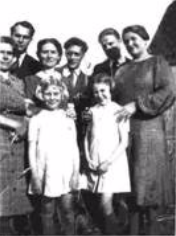
Two young French girls who sang to Zenon while in hiding
The Need For A Move
After a while, Michel became anxious because several villagers were talking discreetly between themselves about the RAF pilot that Michel had saved. He became frightened that someone would overhear this type of concern, so he decided that Charly should be hidden from then on, away from the village. He was also concerned about the number of people who knew in detail of what he had been up to and what might happen if the Germans decided to question them.
Michel with his knowledge of various resistance groups knew they had their own special methods so he arranged a meeting through a woman with two men from Arras in a hairdresser's shop called "Serge". They worked with a group who specialised in helping RAF crews to return to England. A third man arrived late, he being a Gendarme made Charly somewhat worried mainly because of the uniform so he asked to see his papers. Not only did the Gendarme produce them, but he also handed Charly the gun from his holster. Michel assured him that it would be alright, but Zenon decided to stay with Michel and the three men returned to Arras. It was only when they had driven away did Charly realize that he still had the gun.
Raymonde had a friend of Scottish descent whose father named McLeod had been caught hiding a British soldier. He also had a radio transmitter and had acted for the intelligence service. He was taken to East Prussia where he died. The mother was taken to a Polish prison camp but survived the war. They had a son and two daughters who all worked in the mines and lived at St Pierre les Auchel. The eldest daughter was taken to the Gestapo prison at Loos and severely tortured in order to find out if others were involved. Eventually she was released with photos of her ordeal that she
was ordered to show her sister who they said would endure similar punishment if any of the family were caught hiding wanted individuals. Charly was to be hidden by the elder sister and he was to be taken there by Michel in daylight. By this time Charly was sure that he would be stopped due to the frightful looking clothes he was wearing. Also if stopped wearing civilian clothes he knew he would automatically be shot as a spy.
Despite these worries the two of them set off next day towards St Pierre. Michel walked a few steps in front of Charly following on behind, using a stick, complete with beret and a hand-made cigarette dangling from one corner of his mouth. At one point they rounded a bend in the path alongside a wheat field and to their utter amazement and horror they were confronted by a patrol of about 14 or 16 well disciplined German soldiers. Michel walked straight on without batting an eyelid, so Zenon followed with a stern glare on his face and the high-tension danger was over in seconds. Eventually they arrived in front of a block of terraced houses where many grim looking men and women were talking. They had obviously just come from a shift at the mine. After lingering among the group for a while, the two entered one of the houses and was immediately met by a pleasant rather plumb girt "Hello Charly" she said, "I'm pleased to meet you." "I'm a good friend of Raymonde, we went to school together. So don't be afraid you're in safe hands and you'll spend a few days in this house." She then went on to explain with some authority "that he could not leave the house and had to stay in the loft at all times. Unfortunately the loft had no windows and the only light was a 15 watt, 110 volt bulb, but she did provide a bucket, a small wash basin with the minimum of water and a tiny amount of miners' soap that reminded Charly of a piece of stone covered in glass paper. However she promised to visit him every day. She went on to say "that tomorrow everyone must be out on the main road to greet Field Marshall Rommel as he passes on his way to the Normandy front (therefore it most likely was after D-Day, 6 June 1944). However, a man will fetch you called "79" to have your photograph taken for your identity card to be prepared. Tomorrow will be the best day as all German soldiers as well as the Gestapo will be engaged in providing security for the Field Marshall.
Mr 79 duly appeared and they marched off together trying to give the impression they were in deep conversation but Charly had no idea what he was talking about. The photo was quickly taken and they returned while all the crowds were still on the street. He recalled how pleased he was to return to the house to use the bucket! Several days later Mr 79 arrived with Zenon's identity card. The stamp on the photo was made from a raw potato skin and to Charly he thought that it looked far from the real thing. He had been given the name of Charles Leblanc, born somewhere in Bretagne. 79 obviously noted Charly's dissatisfaction because a few days later he was given another. Charly's name this time was Charles Lebrun. Although the standard of the card was better than the first, Charly thought the stamp was still very poor and it would never pass German inspection.
79 also became concerned about Charly's shoes that on close inspection could be seen to have been cut down. He said he knew of someone in a village about 8 km away who could provide a pair but would not do so unless he actually met the person. It was raining hard, so 79 suggested they should make the journey walking across fields' as it was less dangerous. Charly quickly agreed if for no other reason than to be out of the loft breathing fresh air. Eventually they arrived at a small shop that sold almost anything one wanted. The man inside looked Charly over very carefully, went away and came back with an almost brand new pair of working shoes that fitted perfectly. There was no conversation whatsoever between all three and the exchange took place in just a few minutes before they were on their way back.
Charly later said that 79 was a pleasant man around 60 years of age who he later was told had been shot dead on 1st September 1944 close to the spot where both had crossed the road to have his photograph taken. He was buried locally and Charly often visited his grave after the war.
Yet Another Move
Charly lost track of how long he had to stay in the loft before he was introduced by his lady host to the wife of a butcher, whose husband had been taken prisoner. They had had a shop where the wife was allowed to sell meat once a week under German control. She also had a 14 year-old son who was learning to play the violin, an instrument that Charly could play. At once Charly offered to teach the young boy and it was arranged that he would visit their house to do so. However the house was extremely close to several V1 launch sites and the mother and son moved away to sleep elsewhere for a while so Charly had the house all to himself at night. One launch site was so close that he could observe all that was going on. Here he lived almost in luxury, for every lesson he gave, the mother would provide a slice of liver or pork. He would cook these at night when alone and had the run of the house as it was supposedly empty. He watched with the aid of the owner's field glasses each V1 take off whilst listening to BBC London. This allowed him to follow the Allies advance through northern France with the aid of his silk escape map that he still carried and wondered how long it would be before the allies reached him.
Back to Camblain Chatelain
It was not long however before the RAF located the nearby launch site and came to bomb it almost nightly. Then the USAAF heavy daylight bombers took over and Charly's hiding place became extremely dangerous. When Michel heard of this he quickly came to visit Charly and insisted that he return to his village. Michel at this time was becoming heavily engaged in various sabotage activities so Charly often helped in dynamiting railway lines and bridges to delay their use by trains taking supplies to the front.
And yet more Moves
Michel could therefore not look after Zenon as he wanted to and he had to find others who could. He found a most remarkable women named Berthe. Her husband was a shoemaker who owned a modern shop in Marles-les-Mines. She had hidden two British soldiers since 1940 so was well experienced in looking after servicemen. She spoke English with authority and appeared to fear no one. The first thing she said to Charly was "you're going to have a hot bath, I'm sure you have never had one since you came to this country on a visit?" Charly could not believe his luck.
Later he was looked after by a baker/butcher M Stephan Krawczyk in the same area. He understood Polish so it was a natural place for Charly to stay. His host was an active member of the resistance and as he was ordered to provide the Germans with bread and meat he was able to study and locate the defence positions being set up to delay the Allies advance, as well as the V1 launching sites at Ferfay. These were not far from the German airfield at Rely that used the road from Arras to Boulogne as its runway. It was also known as La Chausse Brunehaut. In this way he used his German pass to good advantage and often took Charly along to help him. During these trips, Charly acted as if he was a deaf and dumb employee of M Krawczyk to avoid notice.
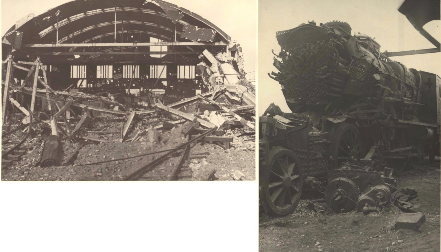
Douai 22nd May 1944
On 2 September 1944 the British Army XXX Corps was sweeping quickly into the area and Michel hurried over by bicycle to collect Charly to meet the advancing British troops and to inform them of the German positions that were set up and waiting to ambush them. He met the troops somewhere between Pernes en Artois and Camblain, but some of their maps were incorrect as the British troops thought they had reached Manes les Mines. At first they did not want to stop but when Charly explained who he was and what he knew the officer in charge allowed him to mark his maps to avoid falling into the German trap.
The results of this prior knowledge was 6 German soldiers killed including the local commanding officer and some 9 wounded. Charly helped to transport the wounded to hospital by removing doors from local houses to use as stretchers and place them on various armoured vehicles.
At long last Zenon's days of Hiding were over.
The following day, Charly was required to report at British headquarters set up at Ferfay where later a reception was given in his name. He was then sent on an assignment with an intelligence officer to prepare for the arrival of RAF aircraft at Vitry en Artois airfield, located between Arras and Douai. However on their way from Camblain to Arras they were stopped by snipers at Ranchicourt and the mission returned to Bruay en Artois (now Bruay Labuissiere) near Bethune.
On 4 September 1944, Charly was flown out of the airfield at Vitry to RAF Hendon north of London to return to his Squadron, a free man and to be known once again as Zenon Bartkowiak.
Postwar statement written by the local head of resistance.
Michel
Before leaving this important part of Zenon's life it is considered necessary to place on record the influential part that Michel played in it.
Michel Salmon was called up for military service in 1940 but was captured by the Germans as they advanced into France but he managed to escape only to find himself in the evacuation of the retreating armies at Dunkirk. After being taken on board a ship and being repeatedly bombed he arrived at Hull on the east coast of England. When the authorities realised he was French they sent him to Southampton on the south coast and placed him on a boat to Le Harve that was not yet occupied by the Germans. His liberty did not last long as yet again, he was arrested by the Germans. This time he was taken to Calais to help build various defences, but once again he escaped. However he was picked up before he could reach his home village and forced to work on other large defence projects. During one of the many air raids on the building of these defences when most were panicking, he managed to escape once more and before he could be apprehended reached home and immediately volunteered to work in the nearby mine. The Germans desperately needed miners at the time so they did not remove him. Furthermore, miners had more liberty than many other French workers and as already mentioned, received additional food rations.
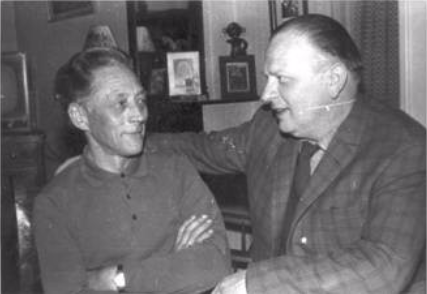
Zenon and Michel many years later
Michel's wartime occupation suited his lifestyle admirably. He had sufficient liberty to help in Raymonde's hairdressing saloon and carry out missions for the resistance. Often he would be asked by residents of other villages to colour certain peoples' hair to change their appearance. He obviously realised what he was doing but did not ask questions.
From that moment onwards in the early evening of 22 May 1944, the two of them would become like "War Brothers" as Zenon later said, though neither could visualise this at the time.
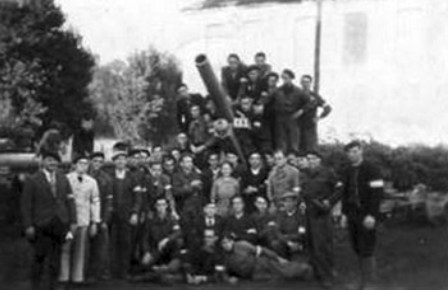
French resistance
Chapter 7
Return to 303 Squadron
RAF Hendon
Zenon obviously flew from Vitry to Hendon as he arrived the same day that he left France, 4 September 1944. The type of plane used is not recorded, but it is likely that he returned in the ubiquitous Douglas Dakota, probably along with other service personnel some of which might have been wounded as the fighting front was then still close to Vitry. On arrival he was interrogated and his report was circulated widely to include several different intelligence departments, presumably in case they considered that Zenon might be able to help them in their current activities. The fact that he hid for a time alongside of a V1 launch site, etc was of possible interest as well as who he contacted while in hiding.
After a medical examination and possibly receiving a new issue of kit, Zenon travelled to the Polish Air Force unit at Blackpool where no doubt he was given leave. During his spell there he was promoted from Flight Sergeant to Warrant Officer effective from 17 October 1944. He returned to 303 Squadron on 4 November that year. Thus he became the first and eventually the only pilot to be shot down in enemy territory while flying with 303 Squadron to return to the unit to fight again.

Telegram sent to 303 Squadron
RAF Coltishall
At this time of the war, 303 Squadron was based at this airfield some 9 miles north of Norwich in Norfolk, not far from the East Anglian coast. It was once again equipped with the Spitfire Mark IXC as it was at RAF Northolt when Zenon joined it in June 1943. His records do not show that he undertook any local familiarisation flights before returning to operations as he had not flown for some 5 months, but no doubt he did so.
By the 30th of November 1944, Zenon was back on operations flying a Ramrod escort, this time to Bottrop just north of Essen in Germany. This would have been a long flight for a Spitfire IXC from Coltishall and return even when fitted with long-range fuel tanks, but perhaps they landed on the way home at one of the recently occupied airfields in Belgium although the flying time of about 2 hours logged did not suggest this. On the first day in December Zenon was airborne in EN 182 RF-Y on an armed reconnaissance operation but was recalled after some 45 minutes owing to an adverse weather report. His records show that on 4th December he was on another armed reconnaissance in the area of The Hague and that he was hit by flak but returned safely. Next day he was scrambled on a rescue mission, but no details were given as to what had to be rescued or where. On the 8th of the month he participated again in an armed reconnaissance but met much cloud and flak up to around 8000 ft some of which hit his aircraft but he returned safely. He flew EN 182 again, RF-Y.
On 10th December when returning home from Amsterdam close to the Hague, Zenon and F/Lt Rzyski had cause to land at Ghent that was in Allied hands, because both reported engine and drop tank troubles. They stayed there for the night and returned to Coltishall the next day. Zenon was flying MA 683, RF-M on this operation.
January 1945 appeared to be a quiet month as far as Zenon's flying was concerned but in February the Squadron once again changed its aircraft type. This time it was equipped with the Spitfire Mark XVI that was virtually a Mark IX with an American Packard-built Merlin 266 in place of the Rolls‐Royce Merlin 66. There were other detail differences and production Marks from this month onwards had cut down rear fuselages with tear drop canopies for better all-round visibility, but it is not known if 303 Squadron received this type. From a piloting viewpoint there was little noticeable difference between the two marks.
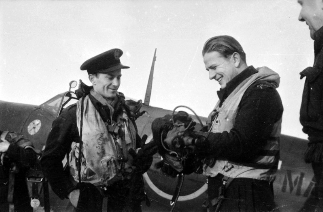
Throughout February and March 1945, Zenon was involved mainly in further armed reconnaissance's' in The Hague area in Holland, although occasionally he was part of an escort to Halifax's, perhaps providing equipment to ground troops by parachute. There was also one anti intruder patrol north of Norwich.
RAF Andrew's Field
On 4 April 1945, 303 Squadron moved south to this base 3 km west of Braintree in Essex. It was the first airfield in England to be built by the US Pioneer Corps who arrived on 4 July 1942 (US Independence Day), hence it was named after a US Lt General rather than the nearby village of Great Saling.
During May at Andrew's Field the Squadron changed aircraft type yet again, first to The North American Mustang Mark I and shortly after to the Mark IV. This last mentioned Mark of aircraft could be described as possibly the finest single-seat, single-engine fighter the Allies had throughout WWII that came about through a British initiative and ultimately through the vast resources of the US. In May 1940 a British Purchasing Commission visited the US in great haste to buy aircraft that were desperately needed by the RAF. North American offered its NA-37 fighter design and the British Commission ordered 300 aircraft straight from the drawing board even though the company had never before designed or flown a fighter. NA undertook to build the prototype within 120 days and was just two days late. When later the US Allison engine was replaced by the Packard Merlin engine it became a remarkable aircraft with the great range of 3328 km and speed of 700 Km/hr at 7620 m altitude.
Squadron code information states that when the Squadron received its Mark IV Mustangs it also replaced its RF code by PD. However photographic evidence shows that several Mark IVs still carried the RF code right up to the time that it was stationed on its last airfield before it was disbanded at RAF Hethel.
Zenon's last operational sortie of WWII was thought to be on 23 April 1945 when he became part of the escort 303 Squadron provided to 148 Lancaster's of 5 Group. They set out to attack the railway yards and port area at Flensburg in Germany near the Danish border, but due to intense cloud cover the raid had to be abandoned. All aircraft returned safely.
303 Squadron also provided an escort to 359 Lancasters and 16 Mosquitos that raided Berchtesgaden on 25 April 1945 against Hitler's 'Eagle Nest' chalet and local SS guard barracks. It was believed to be the last operation in WWII undertaken by 303 Squadron. However, Zenon's records do not show that he took part in this raid.
Eight days after, the war in Europe ended, 303 Squadron was on the move once more.
Back to RAF Coltishall
On 16 May 1945 the Squadron returned to its former base, and still flying their Mustang IVs. Presumably flying was restricted to exercises as Zenon's records show that he flew around 40 hours daylight flying before the Squadron was once again returning to its previous base.
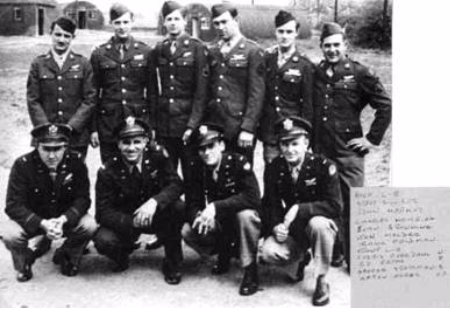
B17 crew pictured thanking 303 Squadron for their skills in fighter protection.
Back to RAF Andrew's Field
Perhaps the RAF was still attempting to decide where the peacetime squadrons should be based as on 1O August 1945, 303 returned to this airfield for a purpose that is not recorded. RAF Coltishall did eventually become a night fighter base so that might have been the reason to move the Mustangs as they were daytime fighters. During his stay up to December, Zenon's record shows that he flew a further 40 hours all presumably on the Mustang VI. However, from 17 September to 5 October 1945 Zenon went to RAF Fairwood Common, about 3 km west of Swansea in South Wales. The purpose of this short stay is not known although the airfield had been formerly connected with armaments.
RAF Turnhouse
On 1 December 1945, 303 Squadron was on the move again, this time to RAF Turnhouse about 3.5 km west of Edinburgh, Scotland to what became much later that city's own airport. The Squadron only stayed a month before it was on the move even further north. Its reason for being there is not known.
RAF Wick
On 5 January 1946 it found itself on the most northeasterly airfield on the mainland of Scotland, just 700 m northwest of Wick itself. During the 2 months the Squadron was based there it took part in intensive 'Dodgem' training exercises. These consisted of simulated raids by 316 Squadron Mustangs attacking targets at Scapa Flow and Dalcross while 303 and other squadrons become part of the defending force. Zenon's flying hours while at these Scottish airfields were very low, possibly due to their location and the time of the year when weather conditions were usually foul. However due to complaints from the local authorities about noise and low flying aircraft, 303 had to once again move.
RAF Charterhall
This airfield was about 15 km east of Berwick-on-Tweed and when 303 Squadron arrived on 6 March 1946 the airfield was in the throes of closing down. The Squadron only stayed for a fortnight and was mainly engaged on air to ground gunnery practice. It was said to be the last flying unit based there. On 23 March it packed its bags once again, but on this occasion it was for the last time.
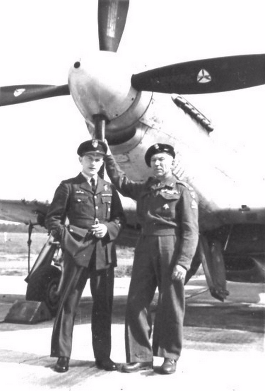
Zenon with his father beside Mustang PD-R
RAF Hethel
This airfield situated some 5 km southwest of Norwich in Norfolk was built in 1941 and for the whole of its wartime life was used by heavy bombers of the USAAF who had returned home by the end of May 1945. On 23 March 1946 when 303 Squadron arrived it joined 316 Squadron with its Mustang Ills. By October 1946, 302 Squadron arrived flying its Spitfire XVIEs along with 308 and 317 Squadrons with their Spitfire XVls. The pilots of all these Squadrons were either Polish or Czechoslovakian and consisted of those who had courageously come to aid the allies eradicate Nazism but with the end of the war found it impossible to return to their homelands then occupied by communist regimes.
In hindsight it appears that UK authorities had assembled all these European fighter pilots and their ground-crews at one location before deciding their future. Despite the rapid demobilisation of UK and other overseas 'hostilities only' air force personnel there remained far too many pilots and aircraft from which to form a peacetime air force. A decision was therefore made in late 1946 to disband all these Squadrons. During the 9 months that 303 Squadron was there Zenon's records show he amassed yet another 40 hours flying time.
On 11 December 1946, 303 Squadron was disbanded. Zenon had flown a total of just a few minutes short of 670 hours with this remarkable Squadron, a not inconceivable record and one he could be proud of. However he like many other of his associates left the Squadron with a very bitter feeling that they had been sold short. Britain and France had given a guarantee on 25 August 1939 that they would come to the aid of Poland if it were attacked yet they took no immediate action and by the end of the war had allowed the USSR to occupy Poland. Zenon was left in a foreign country on his own with no obvious skill other than flying. Life at that point in time must have looked very bleak.
Resettlement
The RAF did however make some attempt by setting up Resettlement Units where various skills were offered as an introduction to civilian life. Zenon's records suggest that he was listed at a Personnel Record Centre, thought to be called No 5 Resettlement Unit, from 13 December 1946. On 5 June 1947 he moved to RAF Watton, SW of Norwich in Norfolk that was then the Central Signals Establishment. It is not known what he did between these dates, nor what he did at Watton until he moved again to RAF Framlingham, west of Saxmundham in Suffolk on 4 November 1948.
No 3 Resettlement Unit was based at Framlingham that was believed to be concerned with the demobilisation of Polish Air Force personnel. This was where Zenon officially left the Polish Air Force on 13 December 1948 and stepped into civilian life. There does not appear to be any record of whether Zenon gained any skill or introduction to one during the period from when 303 Squadron was disbanded to the time he became a civilian.
Zenon had worked in Spondon in a silk factory and then living in Derby 104 Arthur Street (where Jan Bartkowiak was born).
Chapter 8
Life in France
Early days
By the time the Bartkowiak family stepped ashore at Calais, Raymonde's aunt Marguerite had made arrangements for them to have the house she shared with her husband Cyriaque in the rue de l'Egalité, Auchel, just a few metres from a cemetery a place that Charly had an affinity with in 1944. Ironically their neighbours were two brothers, Fernand and Emile Gravure, bachelors who had a small stonemason's business.
To have a place of residence so soon after arriving in France was ideal. Zenon, who once again was known for the rest of his life in France as Charly, was able within a week to start work while Raymonde opened a hairdressers shop in the same street.
Charly cycled daily to work for Stephan Krawczyk's whose shop was in Marles les Mines. A huge Polish community had settled there and in other nearby towns like Calonne-Ricouart, Divion, Bruay-en-Artois (now Bruay-Labuissière), where there were many coal mines, with Auchel being at the end of the Pas-de-Calais deposit. As in England at that time (see Ch 9), coal mining was one of the very few jobs open to ex Poles. Most of these workers lived in estates mainly built in the 1920s with streets named after French or Belgium towns such as rue de Lyon, Bordeaux, Bruxelles, Namur, Liège, etc.
Charly's job was to deliver bread by van to many of the houses in Marles. Although he learned to drive and gained his licence when in England, he still had to attend a French driving school before gaining a French licence. As most of the houses were adjacent to one another in terraced lines he soon found the work comparatively easy and became so familiar with each street that he could name the people living in each house. Most important was that he came to know the exact quantity of bread that each customer required each day despite there being three shifts working in the mines.

Wedding Day
He came to enjoy this job immensely as he could regularly converse with so many people in his own Polish language. Knowing that he met so many fellow Poles and had been stationed abroad, he was frequently asked if he had met, or knew where certain fellow countrymen were at that time. While he was not always able to help immediately he could at least suggest organisations to contact for help, say in London.
Charly soon became very popular with his clientele, more so as some said than the owner of the business or the local Polish priest. Besides having its own priest, the Polish community also had its own choir, athletics and football clubs. As Charly's popularity grew so did his clientele. He was always an early starter and housewives soon began to appreciate his early deliveries. So did Stephan Krawczyk when he noticed the increase in his sales.

Polish chapel
Early days
Within 3 years of arriving in France Charly was about to be given more responsibility when Marguerite, who was close to 63 years of age, decided to give up the café that she owned as her husband who was very ill had to enter hospital in Lille. Subsequently Raymonde and Charly were offered the café for a very small rental.
 The Bartkowiak's become Business Owners
The Bartkowiak's become Business Owners
In 1957 the family moved from rue de l'Egalité to the "Café de la Paix" in rue Roger Salengro where they were to work and live. Charly took over the café and Raymonde the hairdressers next door, both buildings being owned by Marguerite. The position of the café had a potential for tremendous business. It was next to the Post Office as well as St Martin's Church and the Town Hall. The Eldorado dance hall was close by that opened every Saturday and Sunday and the Market being held every Tuesday on the Church Square nearby. Yearly fairs were also held all the way along rue Roger Salengro every Easter and in June. A garage traded alongside of the dance hall, initially dealing in Simca and later Fiat cars. Customers and staff from all these businesses used the café extensively. It opened at 5.30 am each weekday when postmen came for coffee before sorting mail and closed at 9 pm except weekends when it closed at 1 am. Raymonde also transferred all her clientele from her previous shop in the rue de l'Egalité.
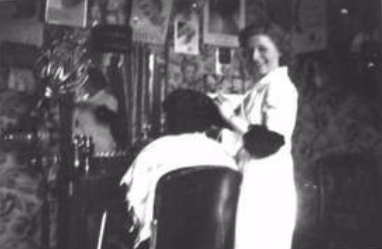
Raymonde's hairdresser business.
Not long after they took over the café it was decided to change its name to "Chez Charly". This was the easy part but now Charly had to be able to learn and speak French in order to run the business. Up to this time Charly had conversed mainly in Polish when dealing with Stephan Krawczyk and most of his clientele and in English when speaking with Raymonde. Despite the fact that she tried her best to teach him French each evening he found it hard not to lapse back into English. Soon his friends, neighbours and even his customers endeavoured to help him and soon he had learned enough to converse sufficiently to be understood. On many an occasion all in the café would burst into laughter and say the owner was speaking patios. Sometimes this was purposely arranged just in jest.
After Charly's father retired from his school job in England in 1960, he came to live in Auchel where he stayed for a year before he returned to where his family lived in Pleszew, Poland. It was then that he learned of the death of his wife who had been shot by the Germans soon after their invasion in 1939. He also learned that his other son met a similar death. His father died in Poland in 1963.
Michel Salmon and his wife Geneviève came from Camblain Châtelain to live in Auchel around the same time as Charly moved. He also settled in the rue Roger Salengro but at the far end about a kilometre from the Café, and opened a hairdressers shop. At that distance away this offered little competition to Raymonde's business. Geneviève who was a schoolteacher also joined those attempting to teach Charly French so with all this help he was at last taking his first steps into a French lifestyle.
Chez Charly becomes Established
In 1964 Charly was approached by the local association of the WW1 and WW2 veterans with a request to hold their monthly meetings and reunions at the cafe. Charly heartily welcomed this arrangement and it was not too long before the President of the Association, M. Gaston Druon made Charly a "Carte du Combattant". He was himself a WW1 soldier and a talented conductor, composer and pianist. However, this could have signified that Charly be granted a war pension, but this was not to be because he had never worn the French uniform. Charly never understood this as his records clearly showed that he had fought the Germans in France both in the air and on the ground.
By this time after WW2 parents allowed their teenagers far more freedom and many attended Saturday evening and Sunday afternoon dances at the nearby Eldorado Hall. It became an extremely popular venue for entertainment for miles around and Chez Charly was a rendez-vous point where young people met to drink a beer, soda or coffee before the dance or during it. It was said that many parents were pleased that their children regularly used the café because the owner was a former Polish pilot with the RAF. Also, his previous work for Stephan Krawcyzk was known by so many people in the neighbourhood.
Similarly many who visited the market each Tuesday came to the café as did many of the shopkeepers in Auchel and soon he and the Café became well known. As his trade grew, so did friendships with both he and Raymonde and it was not long before many of his clientele wanted to know and hear about the escapades of "The Engishman" as he became known, who was in the RAF. He never complained about being called this and always remained proud to be Polish and having served with the Polish Air Force alongside the RAF.
When he spoke about flying Spitfires everyone listened intently. He enthralled them about how he escaped, how he was hidden with Raymonde's and Michel's help. The young ones were eager to learn about the technical details. How easy was it to fly, how much fuel did they carry, how many shells and cartridges did the guns have, how did the radio work, etc, etc. From this interest one youngster joined the French Air Force and became a Captain, another became a helicopter pilot and two obtained their private pilot's license. Others took up model aircraft and it was clear that Charly had passed on his passion for flying from his talks. Often some of these pilots returned his interest by flying low over the Café at weekends.
An Idea comes to Fruition
Michel and Charly had long mulled over the idea of retrieving his Spitfire VB EN 836 that crashed at Camblain Châtelain on May 22 1944. Michel had heard that the farmer on whose land the aircraft had crashed was concerned about a circular area of the field where nothing would grow and from time to time oil came to the surface. This was obviously the site and in August of 1966 it was decided to make an attempt to unearth it.

Retrieving the Spitfire.
Michel had a friend called Henri Poiteaux who owned a civil engineering company that had access to bulldozers, cranes and men who could undertaken this task, So early one bright Sunday morning in May at 7 am work commenced under the watchful eye of the local Gendarmerie to keep back onlookers all curious to see what was happening, as well as to prevent accidents. By 11 am a discovery was made that forced Michel to drive rapidly to Auchel in his navy blue NSU Prince to inform Charly that among the many items that had been unearthed they had found a bomb and that it was hissing. In the meantime all work had stopped and a cordon was thrown round the site.
Charly calmed Michel down by informing him that his Spitfire could not and did not carry any bombs. When Charly arrived at the site there was laughter all round as the hissing was coming from an oxygen bottle that had remained in the clay soil for some 22 years and was still in excellent condition. The same could be said for the Merlin engine that was unearthed later although somewhat battered. Also found was the piece of shrapnel that caused Charly to bale out and his leather helmet full of oil. Charly considered that he had accomplished another success by bringing his Spitfire, or the remains of it, to the surface again after 22 years which brought tears to his eyes.
Michel and Charly continued to commemorate the moment they first met on 22 May each year at 19.10 hrs with a glass or two of champagne as they never wanted to forget it. Charly said that he owed so much to Michel who risked his life every minute of the day for that guy who came from the sky before the Allies came to liberate that part of France. Michel was so special to Charly that he wrote to the RAF Escape Society requesting a decoration for his "Brother in Arms" which Michel received in Calais from a high ranking RAF officer in the presence of the HM Consul in Lille.
As a footnote to recovering Charly's Spitfire, a M. Roland Potier contacted Jan, Charly's son in July 2004, to recount his action as a witness to the crash when 16 years of age. Living close by he visited the crash site next day and from amongst the debris he picked up a yellow bag that he took home. It was of course the dinghy and from one side he found a box containing what he thought were sweets. Having taken some he couldn't sleep for 3 days. They were pills intended to keep the pilot awake until rescued. Unfortunately Roland's father ordered him to throw it away in fear of the Germans might come to search the house. His mother made a pair of gloves from parts of Charly's parachute.
Charly's interest in Football & 1966 in particular
Charly had followed the game of football very closely when in England, in fact he used to boast that he had visited most of the major club grounds when based in that country. He was a keen supporter of Ipswich Town and Norwich as well as Nottingham Forest when he worked in the textile factory in Spondon even though he lived at Derby. But later when his son was born at Derby, he also became a fan of the Rams, so when what was considered the local derby between Nottingham Forest and Derby County, Charly was in his element.
Charly had not been to Wembley, the site of the premier ground in England, since 1948 so when the final of the World Cup match was to be played there in 1966 he was determined to be there again. He organised, through friends in London, to acquire tickets for several colleagues in France to make the journey from Auchel to watch England beat Germany. Perhaps his reason for being in England in 1940 and then later in France had something to do with his excitement with the result.
Changes in the 1970s
By the end of the 1960s, Raymonde gave up regular hairdressing as the constant use of the new hair products being introduced had started to affect her health, particularly her breathing. She and Charly decided to update the Café to make it more attractive to their clientele, especially to the new generation of teenagers. So it was closed for almost a month for a facelift.
Charly reopened it in style by inviting his friends and certain dignitaries including members of the Municipality Board, local Police authorities and Lady Amos, the British Consul in Lille. The friendship with Lady Amos had grown from the help that Charly had given to English tourists. Close to Auchel is Cauchy-á accident-la-Tour where there was a spot called "La Guillotine" on the main road from Calais to St Pol/Ternoise that was notorious for accidents particularly involving British tourists. The local Police frequently asked Charly to become an interpreter to give information and comfort to British citizens at the scene of accidents. Lady Amos heard about his good work and they became friends for many years.
The Marriage of their Son
It was planned that Jan would marry Vivianne Gavrel on 15 June 1974. The plan included inviting Charly's sister Janina and her husband Franek with daughters Hania and Genia and son Dzislaw. However this was not to be. Only Janina and Hania were granted permission to leave Poland. At this stage of the cold war, the Polish authorities forbade a whole family for any reason to leave the country and furthermore, those leaving had to have the return journey prepaid for by the family in the country to be visited.
Even so, it was tremendous news for Charley as he was to see his sister for the first time in 35 years since he fled Poland in 1939. Despite having to make such plans well ahead, he did have to wait a very long time for official agreement to be received from the Polish Consulate in Lille via the Polish Embassy in Paris. As soon as he received this golden news he immediately phoned his sister in Pleszew. This took him some 7 hours to be connected. She in return was extremely pleased as she herself had not then known that such permission had been granted. The numerous letters that he sent to his sister took almost a month to reach her due to the Polish censor. Eventually he heard that his sister and niece had received their tickets for departure from Poznan in Poland to the French station at Aulnoye near Maubeuge due to arrive at 7.10 pm on Monday 10 June.
Charly informed Michel that he knew the directions from Auchel to Aulnoye and estimated it would take 1½ hours by road. However he had forgotten that he had arranged an afternoon business meeting that day with the manager of a brewery in Dunkirk that he couldn't cancel. At 5 pm he realised that he had to travel some 150km in just over 2 hours. Up to that point he was renowned for his time keeping but low and behold some 10km from Aulnoye he took the wrong direction. As he said, "he flew all over France and Germany escorting bombers and never once lost his way, yet on this most important occasion he had."
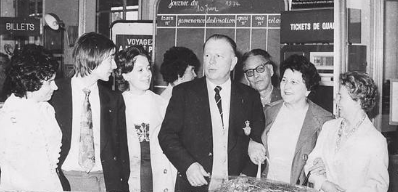
Aulnoye Station
Jan and his fiancée Vivianne with Michel and Geneviève, plus two local journalists had already arrived waiting for Charly and Raymonde to do so. As they could wait no longer they walk on to the platform to find two lonely ladies sitting on a bench wondering whether they had arrived at the wrong station. One of the journalists immediately recognised the likeness of one with Charly who arrived with Raymonde some 10 minutes later.
After a quick drink in the station cafeteria they were all on their way to Cambrai for a meal then on to Auchel. For the rest of the week until the wedding day on Saturday brother and sister spoke endlessly about so many things. How his brother was shot, what life was like under the Germans and what Poland was like to live in now. Not all was sadness for there were great meals with Raymonde, Janina and Hania, Michel and his wife and with his future daughter-in-law's parents.
The day of the wedding celebration arrived and in the tiny church at Calonne-Ricouart there were as many people outside as there were inside. The priest had never seen so many people at a wedding and the event took place on the eve of Father's Day, a day all the family will remember. Hardly had the stroke of midnight sounded when Charly collapsed in the large restaurant room of l' Escale in Lapugnoy. He became pale and breathless and a doctor in the hall advised that he had to be taken home at once. So with the help of Michel, Raymonde and the newly weds, he was quickly taken back to Auchel. The family doctor was called at once and after examining him said that it was his heart. In the early hours of June 16 he was taken to Arras General Hospital where he stayed for 40 days having avoided a severe heart attack. Events leading up to this time most likely contributed to his condition. The arrangements for his sister and niece to visit them, the sad news they brought with them, his mad dash from Dunkirk to Aulnoye, plus all the wedding activities, etc, must have stressed him severely.
Raymonde was left with her aunt Marguerite to run the Café with the two Polish ladies who could speak no French or English. Luckily Polish speaking friends of Charly's came to the rescue who took them to their homes so they could understand how Charly was progressing and why they could not see him. In the meantime, only Raymonde was permitted to visit Charly and then for but a few minutes at a time until his health improved.
In mid-July 1974 Janina and daughter returned home to Poland and all except Charly was on the platform at Aulnoye to kiss them farewell and make sure they boarded it during its one minute stop after arriving from Paris and then onward via Frankfurt and Berlin to Poznan. Their visit had been memorable in more than one sense.
In August that year Charly came out of hospital and was told to rest from his business for at least 8 months. He was placed on a strict diet that was somewhat difficult for a Pole to accept. There was to be no lifting of barrels in the cellar, no more long working hours, no more smoking (he used to smoke 2 packets of camels per day), etc. This was extremely hard to endure for 8 months, but as the French saying goes "he had to learn how to put water into his wine". To help him he received many get well messages from his friends and customers and after that time was up he was back again in his business.
The 1980s
Life at the Café continued peacefully until on the eve of Charly's birthday on 19 November 1980 his grandson Stéphane was born. Then on 17 November 3 years later his granddaughter Monique arrived. It was as he said as if God had offered him a gift so close to his birthday in those two years. However in 1986 life became a little more serious as he had to enter hospital for a triple bypass heart operation. All went well but it obviously affected his stature from then on and he had to be extra careful in what he did. However, this didn't stop his annual trip in May of each year with Raymonde to the meeting in Blackpool of the Polish Air Force Association where he met all his old friends and colleagues he knew during the war and since.
In February 1989 Raymonde's aunt Marguerite died and on 31 March that year Charly and Raymonde had their last evening in Chez Charly because they were about to retire. All their friends came to have a Last Drink with them. When they awoke next morning they realised they were both pensioners. They had sold it to a young couple from Hazebrouck.
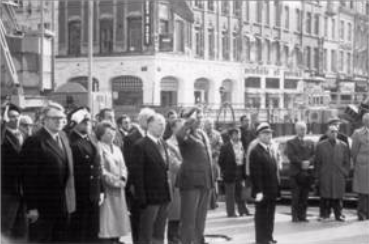
Lille Parade
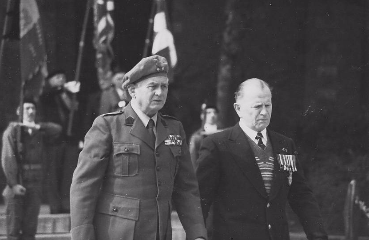
October 1980 Lille homage to the Polish
This meant a move and a house was built next to the Police station and the hospital, in front of the Fire station. So whenever friends from the UK asked where he lived when they wanted to pay him a visit, he replied "just ask for the Fire station. You will see a propeller over my garage door. Drop your luggage and ring the bell and I'll appear."
Charly's last formal duty was in Lille. He had been invited by the Polish Consul and representatives of the Polish Armed Forces to lay a wreath on the War Memorial in Place Rihour in tribute to the 8300 Polish soldiers killed in France during WW2. Later he was to say that this duty was the saddest he had to carry out as it brought back too many memories.
The 1990s
Charly and Raymonde continued to visit their old friends. For example, in June 1994 they visited the site of the old airfield at Coolham in Sussex where a commemorative stone was laid nearby. This was the home of 306 and 315 Polish Air Force Squadrons in 1944 and several of the wartime pilots known to Charly were present. Arrangements were also planned for Charly to meet with the author of the small book on Horne, the airfield from which Charly took off from on that fateful day, 22 May 1944. Unfortunately during the two day activities they missed one another, but afterwards continued to correspond and much of the detail in Ch 2 and 7 are based on long letters Charly wrote to Brian Buss.
In September of that year a stone was also erected with a plaque, on the site of the old airfield at Horne when a Polish pilot that flew with Charly's 303 Squadron was present for the unveiling. Due to his earlier visit to the UK that year, Charly sadly could not attend, but he was remembered.
Sadly, Michel died in November 1996 and Charly lost his "War Brother", and a close relationship that had lasted over 42 years.
The last and probably their most important trip especially to Charly, was to Poland at the end of the 1990s. They decided to drive to Pleszew to see his family, a not inconsiderable journey to take at his age but one he had to make to say he had returned. On arriving he could hardly believe what he saw. Every thing had of course changed since he left in 1938. He recalled their house was not completed when he left to attend the Military School. Now the house in Ul Batorego (Batorego St) was decorated fit to welcome a president. Janina had enthusiastically told all her neighbours that her brother was back after 60 years away.
Charly and Raymonde visited most of the Polish large cities, but he didn't visit Krosno where he trained back in 1939 despite being in Krakow because of all the bad memories he said it would evoke. When back in France he said that misery and poverty was still much in evidence in Poland but change had taken place compared to that described by his sister back in 1974 when she visited Auchel, and from the frequent phone calls between them in the meantime.
The new Century
They continued to enjoy their retirement immensely. For Raymonde it was for 13 years but sadly she died on 8 January 2001, just two days before her 80th birthday. Charly had a further year and passed away on 7 February 2002 at 81 years of age. Both were buried on the same date, the 11th in Auchel in the cemetery off rue de L'Egalite, back to where their life together in France really began.
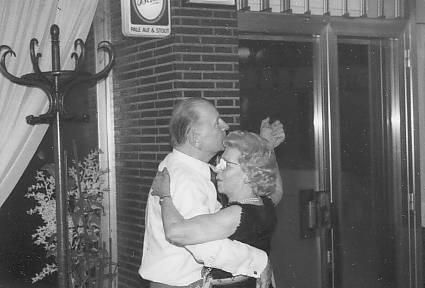 Charly's Epitaph
Charly's Epitaph
He led a full life and is worthy of being recognised by three countries. First, by his own country Poland by taking up arms and joining forces with those that he thought would free his homeland of the aggressor. Also by keeping such strong ties with other nationals outside of Poland. Second, by the UK who he helped rid the world of Nazism. Thirdly, by France because he became one of its community before and after he became a French national on 29 January 1959 and he continued to serve it with a passion for the remainder of his life.
Unfortunately his gravestone does not say all this, but for those who knew him they understand that the simple engraving covers it all - "Charly Pilot RAF"
The gravestone also shows a drawing of a North American Mustang, the last type of aircraft he flew.
The Final Tribute
On Sunday 5 September 2004 many official ceremonies took place on the 60th anniversary of the liberation of France. In Auchel, Charly's son Jan was asked to receive from the Lord Mayor Richard Jarrett, a Medal of Honour from the City as a tribute to his father Charly (born Zenon Stephan Teofil) Bartkowiak.
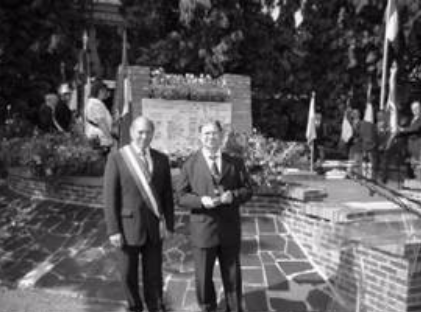
Jan and the Mayor
LONG MAY HE REST IN PEACE
|
